Viavi Solutions 22073946 WiFi Advisor User Manual WiFi Advisor User s Guide
Viavi Solutions Inc. WiFi Advisor WiFi Advisor User s Guide
Contents
- 1. User Manual V1
- 2. User Manual V1 part 1 of 2
- 3. User Manual V1 part 2 of 2
User Manual V1 part 1 of 2

WiFi Advisor
Wireless LAN Analyzer
User’s Guide

WiFi Advisor Wireless LAN Analyzer User’s Guide
Page ii 22073751, Rev. 002 December 2014
Notice
Every effort was made to ensure that the information in this manual was accurate
at the time of printing. However, information is subject to change without notice, and
JDS Uniphase reserves the right to provide an addendum to this manual with infor-
mation not available at the time that this manual was created.
Copyright
© Copyright 2014 JDS Uniphase Corporation. All rights reserved. JDSU, and the
JDSU logo are trademarks of JDS Uniphase Corporation (“JDS Uniphase”). No part
of this guide may be reproduced or transmitted electronically or otherwise without
written permission of the publisher.
Copyright release
Reproduction and distribution of this guide is authorized for Government purposes
only.
Trademarks
JDSU, WiFi Advisor, and TrueMargin are trademarks or registered trademarks of
JDSU in the United States and/or other countries.
iPad is a trademark or registered trademark of Apple.
Bluetooth is a registered trademark of The Bluetooth SIG, Inc. in the United States
and/or other countries.
All trademarks and registered trademarks are the property of their respective
companies.
Ordering information
This guide is a product of JDSU's Technical Information Development Department,
issued as part of the WiFi Advisor. The catalog number for a published guide is
ML-WFED-300AC.

WiFi Advisor Wireless LAN Analyzer User’s Guide
December 2014 22073751, Rev. 002 Page iii
Terms and conditions
Specifications, terms, and conditions are subject to change without notice. The
provision of hardware, services, and/or software are subject to JDSU’s standard
terms and conditions, available at www.jdsu.com/terms.
FCC Notice
This product was tested and found to comply with the limits for a Class A digital
device, pursuant to Part 15 of the FCC Rules. These limits are designed to provide
reasonable protection against harmful interference when the equipment is operated
in a commercial environment. This product generates, uses, and can radiate radio
frequency energy and, if not installed and used in accordance with the instruction
manual, may cause harmful interference to radio communications. Operation of this
product in a residential area is likely to cause harmful interference, in which case
you will be required to correct the interference at your own expense.
This equipment complies with FCC radiation exposure limits set forth for an uncon-
trolled environment. This equipment has been SAR-evaluated for use in hand. SAR
measurements are based on a 10 mm spacing from the body and that compliance
is achieved at that distance. Keep the device away from your body to meet the
distance requirement.
This transmitter must not be co-located or operating in conjunction with any other
antenna or transmitter.
The authority to operate this product is conditioned by the requirements that no
modifications be made to the equipment unless the changes or modifications are
expressly approved by JDSU.

WiFi Advisor Wireless LAN Analyzer User’s Guide
Page iv 22073751, Rev. 002 December 2014
Industry Canada Requirements
This Class A digital apparatus complies with Canadian ICES-003.
Cet appareil numérique de la classe A est conforme à la norme NMB-003 du
Canada.
This device complies with Industry Canada license-exempt RSS standard(s). Oper-
ation is subject to the following two conditions: (1) this device may not cause inter-
ference, and (2) this device must accept any interference, including interference
that may cause undesired operation of the device.
Le présent appareil est conforme aux CNR d'Industrie Canada applicables aux
appareils radio exempts de licence. L'exploitation est autorisée aux deux conditions
suivantes : (1) l'appareil ne doit pas produire de brouillage, et (2) l'utilisateur de
l'appareil doit accepter tout brouillage radioélectrique subi, même si le brouillage
est susceptible d'en compromettre le fonctionnement.
This equipment complies with Industry Canada radiation exposure limits set forth
for an uncontrolled environment.
Cet équipement est conforme à l'exposition aux rayonnements Industry Canada
limites établies pour un environnement non contrôlé.
(i) the device for operation in the band 5150-5250 MHz is only for indoor use to
reduce the potential for harmful interference to co-channel mobile satellite systems;
(ii) This equipment complies with IC radiation exposure limits set forth for an uncon-
trolled environment. This equipment has been SAR-evaluated for use in hand. SAR
measurements are based on a 0mm spacing from the body and that compliance is
achieved at that distance. Keep the device away from your body to meet the
distance requirement.
(iii) This device complies with Industry Canada license-exempt RSS standard(s).
Operation is subject to the following two conditions: (1) this device may not cause
interference, and (2) this device must accept any interference, including interfer-
ence that may cause undesired operation of the device.
(i) l'appareil pour fonctionner dans la bande 5150-5250 MHz est réservé à une util-
isation en intérieur afin de réduire les risques d'interférences nuisibles à la co-canal
avec les systèmes mobiles par satellite;
(ii) Cet équipement est conforme aux limites IC d'exposition aux radiations définies
pour un environnement non contrôlé. Cet équipement a été SAR-évalué pour une

WiFi Advisor Wireless LAN Analyzer User’s Guide
December 2014 22073751, Rev. 002 Page v
utilisation dans la main. Des mesures SAR sont basés sur un espacement 0 mm à
partir du corps et qui est obtenue conformément à cette distance. Gardez l'appareil
loin de votre corps pour répondre à l'exigence de la distance.
(iii) Cet appareil est conforme avec Industrie Canada exempts de licence standard
RSS (s). Son fonctionnement est soumis aux deux conditions suivantes: (1) ce
dispositif ne doit pas causer d'interférences et (2) cet appareil doit accepter toute
interférence, y compris les interférences qui peuvent causer un mauvais fonc-
tionnement de l'appareil.
CE
R&TTE Directive Compliance. This product is in compliance with essential require-
ments and other relevant provisions of Directive 1999/5/EC.
EMC Directive Compliance
This product was tested and conforms to the EMC Directive, 89/336/EEC as
amended by 92/31/EEC and 93/68/EEC for electromagnetic compatibility. A copy
of the Declaration of Conformity is provided in printed form with the instrument.
Low Voltage Directive Compliance
This product was tested and conforms to the Low Voltage Directive, 73/23/EEC as
amended by 93/68/EEC. Conformity with this directive is based upon compliance
with the harmonized safety standard, EN61010-1:2010.
WEEE and Battery Directive Compliance
JDSU has established processes in compliance with the Waste Electrical and Elec-
tronic Equipment (WEEE) Directive, 2002/96/EC, and the Battery Directive, 2006/
66/EC.
This product, and the batteries used to power the product, should not be disposed
of as unsorted municipal waste and should be collected separately and disposed of
according to your national regulations. In the European Union, all equipment and
batteries purchased from JDSU after 2005-08-13 can be returned for disposal at the
end of its useful life. JDSU will ensure that all waste equipment and batteries

WiFi Advisor Wireless LAN Analyzer User’s Guide
Page vi 22073751, Rev. 002 December 2014
returned are reused, recycled, or disposed of in an environmentally friendly manner,
and in compliance with all applicable national and international waste legislation.
It is the responsibility of the equipment owner to return equipment and batteries to
JDSU for appropriate disposal. If the equipment or battery was imported by a
reseller whose name or logo is marked on the equipment or battery, then the owner
should return the equipment or battery directly to the reseller.
Instructions for returning waste equipment and batteries to JDSU can be found in
the Environmental section of JDSU’s web site at www.jdsu.com. If you have ques-
tions concerning disposal of your equipment or batteries, contact JDSU’s WEEE
Program Management team at WEEE.EMEA@jdsu.com.

WiFi Advisor Wireless LAN Analyzer User’s Guide
December 2014 22073751, Rev. 002 Page vii
Contents
About This Guide
xi
Purpose and scope . . . . . . . . . . . . . . . . . . . . . . . . . . . . . . . . . . . . . . . . . . .xii
Assumptions. . . . . . . . . . . . . . . . . . . . . . . . . . . . . . . . . . . . . . . . . . . . . . . .xii
Safety and compliance information . . . . . . . . . . . . . . . . . . . . . . . . . . . . . . . .xii
Conventions . . . . . . . . . . . . . . . . . . . . . . . . . . . . . . . . . . . . . . . . . . . . . . . .xii
Chapter 1 WiFi Advisor Overview
1
About the Wireless LAN Analyzer . . . . . . . . . . . . . . . . . . . . . . . . . . . . . . . . . 2
Architecture . . . . . . . . . . . . . . . . . . . . . . . . . . . . . . . . . . . . . . . . . . . . . . . . 2
About the WiFi Advisor . . . . . . . . . . . . . . . . . . . . . . . . . . . . . . . . . . . . . . . . 3
Features and capabilities. . . . . . . . . . . . . . . . . . . . . . . . . . . . . . . . . . . . 3
Quick tour . . . . . . . . . . . . . . . . . . . . . . . . . . . . . . . . . . . . . . . . . . . . . . 4
Top view . . . . . . . . . . . . . . . . . . . . . . . . . . . . . . . . . . . . . . . . . . . . 4
Front view . . . . . . . . . . . . . . . . . . . . . . . . . . . . . . . . . . . . . . . . . . . 6
Back view . . . . . . . . . . . . . . . . . . . . . . . . . . . . . . . . . . . . . . . . . . . 7
About the WiFi Advisor app . . . . . . . . . . . . . . . . . . . . . . . . . . . . . . . . . . . . . 8
Chapter 2 Managing Devices
11
Connecting a WiFi Advisor for the first time . . . . . . . . . . . . . . . . . . . . . . . . . 12
Registering and unregistering devices. . . . . . . . . . . . . . . . . . . . . . . . . . . . . 12
Changing the power off delay. . . . . . . . . . . . . . . . . . . . . . . . . . . . . . . . . . . 13
Updating the firmware . . . . . . . . . . . . . . . . . . . . . . . . . . . . . . . . . . . . . . . . 14
Updating the iPad application software . . . . . . . . . . . . . . . . . . . . . . . . . . . . 15

Contents
WiFi Advisor Wireless LAN Analyzer User’s Guide
Page viii 22073751, Rev. 002 December 2014
Chapter 3 Testing
17
WiFi Troubleshooting . . . . . . . . . . . . . . . . . . . . . . . . . . . . . . . . . . . . . . . . . 18
BSSID results . . . . . . . . . . . . . . . . . . . . . . . . . . . . . . . . . . . . . . . . . . . 18
Channel view . . . . . . . . . . . . . . . . . . . . . . . . . . . . . . . . . . . . . . . . . . . 20
Spectral results . . . . . . . . . . . . . . . . . . . . . . . . . . . . . . . . . . . . . . . . . . 22
Navigating the Spectral result screen . . . . . . . . . . . . . . . . . . . . . . . 23
Troubleshooting Spectral measurements . . . . . . . . . . . . . . . . . . . . .24
Assessing WiFi performance throughout a site . . . . . . . . . . . . . . . . . . . . . . . 25
Getting started . . . . . . . . . . . . . . . . . . . . . . . . . . . . . . . . . . . . . . . . . . 26
Specifying settings. . . . . . . . . . . . . . . . . . . . . . . . . . . . . . . . . . . . . . . . 26
Step 1: Selecting devices. . . . . . . . . . . . . . . . . . . . . . . . . . . . . . . . 26
Step 2: Specifying the Broadband Service Rate . . . . . . . . . . . . . . . .27
Step 3: Specifying the configuration. . . . . . . . . . . . . . . . . . . . . . . . . 28
Step 4: Specifying the AP and Station Location. . . . . . . . . . . . . . . . . 30
Assessing an installation site . . . . . . . . . . . . . . . . . . . . . . . . . . . . . . . . 30
Interpreting Site Assessment results . . . . . . . . . . . . . . . . . . . . . . . . . . .32
Viewing Location Results . . . . . . . . . . . . . . . . . . . . . . . . . . . . . . . . . . . 35
Managing jobs . . . . . . . . . . . . . . . . . . . . . . . . . . . . . . . . . . . . . . . . . . . . . . 35
Creating a new job in Job Manager . . . . . . . . . . . . . . . . . . . . . . . . . . . . 36
Saving to a new job in the Site Assessment test . . . . . . . . . . . . . . . . . . . 36
Activating or deactivating jobs. . . . . . . . . . . . . . . . . . . . . . . . . . . . . . . . 37
Viewing job results. . . . . . . . . . . . . . . . . . . . . . . . . . . . . . . . . . . . . . . . 37
Exporting jobs . . . . . . . . . . . . . . . . . . . . . . . . . . . . . . . . . . . . . . . . . . . 39
Deleting jobs. . . . . . . . . . . . . . . . . . . . . . . . . . . . . . . . . . . . . . . . . . . . 40
Troubleshooting Problems with Your WiFi Advisor . . . . . . . . . . . . . . . . . . . . . 41
Appendix A Maintenance and Specifications
43
Charging the battery. . . . . . . . . . . . . . . . . . . . . . . . . . . . . . . . . . . . . . . . . . 44
Replacing the battery pack . . . . . . . . . . . . . . . . . . . . . . . . . . . . . . . . . . . . . 44
Cleaning the instrument . . . . . . . . . . . . . . . . . . . . . . . . . . . . . . . . . . . . . . . 45
Specifications . . . . . . . . . . . . . . . . . . . . . . . . . . . . . . . . . . . . . . . . . . . . . . 46
Getting Technical Assistance. . . . . . . . . . . . . . . . . . . . . . . . . . . . . . . . . . . . 47
Appendix B WiFi Fundamentals
49
WiFi deployment . . . . . . . . . . . . . . . . . . . . . . . . . . . . . . . . . . . . . . . . . . . . 50
Network standard. . . . . . . . . . . . . . . . . . . . . . . . . . . . . . . . . . . . . . . . . . . . 50
802.11 specifications . . . . . . . . . . . . . . . . . . . . . . . . . . . . . . . . . . . . . . . . . 51

Contents
WiFi Advisor Wireless LAN Analyzer User’s Guide
December 2014 22073751, Rev. 002 Page ix
Spectrum Differences . . . . . . . . . . . . . . . . . . . . . . . . . . . . . . . . . . . . . . . . 51
2.4 GHz Spectrum . . . . . . . . . . . . . . . . . . . . . . . . . . . . . . . . . . . . . . . 51
5 GHz Spectrum. . . . . . . . . . . . . . . . . . . . . . . . . . . . . . . . . . . . . . . . . 53
Appendix C Customer Services and Support
55
About our services . . . . . . . . . . . . . . . . . . . . . . . . . . . . . . . . . . . . . . . . . . 56
Standard support services . . . . . . . . . . . . . . . . . . . . . . . . . . . . . . . . . . . . . 56
Instrument repair and calibration services . . . . . . . . . . . . . . . . . . . . . . . 56
Technical assistance (business hour) . . . . . . . . . . . . . . . . . . . . . . . . . . 57
Warranty information. . . . . . . . . . . . . . . . . . . . . . . . . . . . . . . . . . . . . . 57
Product documentation library . . . . . . . . . . . . . . . . . . . . . . . . . . . . . . . 57
Add-on services . . . . . . . . . . . . . . . . . . . . . . . . . . . . . . . . . . . . . . . . . . . . 57
Extended product and systems support services . . . . . . . . . . . . . . . . . . 58
Professional and consulting services . . . . . . . . . . . . . . . . . . . . . . . . . . 59
Managed services . . . . . . . . . . . . . . . . . . . . . . . . . . . . . . . . . . . . . . . 59
Training options . . . . . . . . . . . . . . . . . . . . . . . . . . . . . . . . . . . . . . . . . . . . 59
Glossary
61
Index
63

Contents
WiFi Advisor Wireless LAN Analyzer User’s Guide
Page x 22073751, Rev. 002 December 2014

WiFi Advisor Wireless LAN Analyzer User’s Guide
December 2014 22073751, Rev. 002 Page xi
About This Guide
This prefix explains how to use this manual. Topics discussed include the following:
•“Purpose and scope” on page xii
•“Assumptions” on page xii
•“Safety and compliance information” on page xii
•“Conventions” on page xii

About This Guide
Purpose and scope
WiFi Advisor Wireless LAN Analyzer User’s Guide
Page xii 22073751, Rev. 002 December 2014
Purpose and scope
The purpose of this guide is to help you successfully use the WiFi Advisor features
and capabilities. This guide includes task-based instructions that describe how to
install, configure, use, and troubleshoot the WiFi Advisor. Additionally, this guide
provides a complete description of JDSU’s warranty, services, and repair informa-
tion, including terms and conditions of the licensing agreement.
Assumptions
This guide is intended for novice, intermediate, and experienced users who want to
use the WiFi Advisor effectively and efficiently. We are assuming that you have
basic computer and iPad experience and are familiar with basic telecommunication
and WiFi concepts and terminology.
Safety and compliance information
Safety and compliance information for the instrument are provided in printed form
and ship with your instrument. Refer to 22073762, WiFi Advisor Safety Information.
Conventions
This guide uses typographical and symbols conventions as described in the
following tables.
Table 1 Text formatting and other typographical conventions
Item(s) Example(s)
Buttons, keys, or switches that you
press or flip on a physical device. Press the On button.
– Press the Enter key.
– Flip the Power switch to the on position.
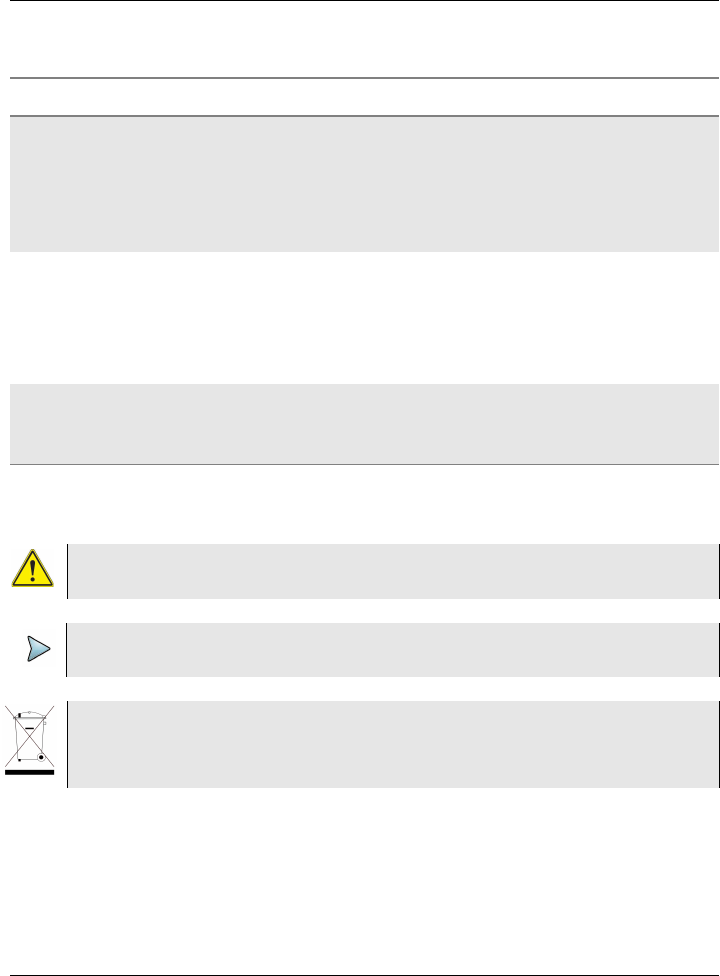
About This Guide
Conventions
WiFi Advisor Wireless LAN Analyzer User’s Guide
December 2014 22073751, Rev. 002 Page xiii
Table 2 Symbol conventions
Buttons, links, menus, menu options,
tabs, or fields on a PC-based or
Web-based user interface that you
click, select, or type information into.
Click Start.
– Click File > Properties.
– Click the Properties tab.
– Type the name of the probe in the Probe
Name field.
Directory names, file names, and
code and output messages that
appear in a command line interface
or in some graphical user interfaces
(GUIs).
$NANGT_DATA_DIR/results (directory)
–test_products/users/default-
User.xml (file name)
–All results okay. (output mes-
sage)
References to guides, books, and
other publications appear in this
typeface.
Refer to Newton’s Telecom Dictionary.
Table 1 Text formatting and other typographical conventions (Continued)
Item(s) Example(s)
This symbol represents a general hazard. It may be associated with either a DAN-
GER, WARNING, or CAUTION message.
This symbol indicates a note that includes important supplemental information or tips
related to the main text.
This symbol, located on the equipment, battery, or the packaging indicates that the
equipment or battery must not be disposed of in a land-fill site or as municipal waste,
and should be disposed of according to your national regulations.

About This Guide
Conventions
WiFi Advisor Wireless LAN Analyzer User’s Guide
Page xiv 22073751, Rev. 002 December 2014
Table 3 Safety definitions
DANGER
Indicates a potentially hazardous situation that, if not avoided, will
result in death or serious injury. It may be associated with either a
general hazard, high voltage, or risk of explosion symbol.
WARNING
Indicates a potentially hazardous situation that, if not avoided, could
result in death or serious injury. It may be associated with either a
general hazard, high voltage, or risk of explosion symbol.
CAUTION
Indicates a potentially hazardous situation that, if not avoided, could
result in minor or moderate injury and/or damage to equipment.
It may be associated with either a general hazard, high voltage, or risk
of explosion symbol.
When applied to software actions, indicates a situation that, if not
avoided, could result in loss of data or a disruption of software opera-
tion.

1
WiFi Advisor Wireless LAN Analyzer User’s Guide
December 2014 22073751, Rev. 002 Page 1
Chapte r 1
WiFi Advisor Overview
This chapter provides a general description of the WiFi Advisor. Topics discussed
in this chapter include the following:
•“About the Wireless LAN Analyzer” on page 2
•“Architecture” on page 2
•“About the WiFi Advisor” on page 3
•“About the WiFi Advisor app” on page 8
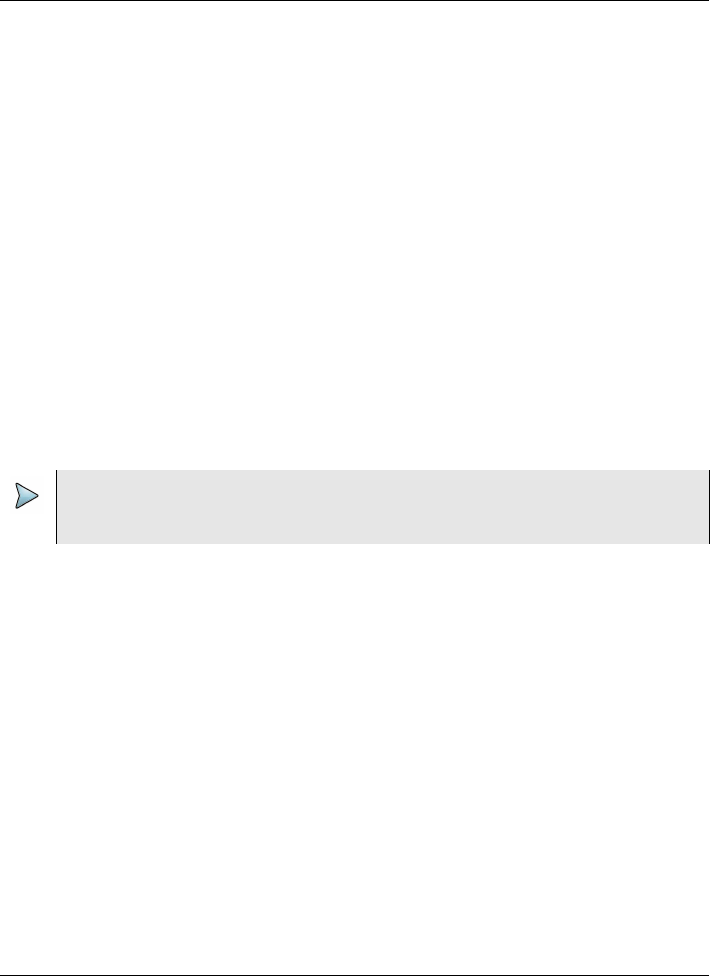
Chapter 1 WiFi Advisor Overview
About the Wireless LAN Analyzer
WiFi Advisor Wireless LAN Analyzer User’s Guide
Page 2 22073751, Rev. 002 December 2014
About the Wireless LAN Analyzer
The Wireless LAN Analyzer provides a complete, multi-dimensional map of real
WiFi performance, highlighting margin and resiliency of WiFi connections at
multiple locations within a site (versus a simple signal strength icon). It includes
intuitive tools to quickly optimize and troubleshoot the in-home WiFi network. After
the test, it provides valuable performance information to the end-user to help
reduce unnecessary trouble calls and repeats.
Architecture
The system architecture of the Wireless LAN Analyzer solution includes the
following:
1 The WFED-300AC WiFi Advisor test device. Each WiFi Advisor contains an
802.11 radio, spectrum analyzer, and a network processor. The device is
responsible for performing tests requested by the iOS WiFi Advisor iOS
Application.
2 The WiFi Advisor iOS Application. This software runs on an Apple iPad
(iPad 2 or newer, with iOS 7.x.x or newer).
The application allows the user to set up WiFi tests, communicates test setups to
the WFED-300AC WiFi Advisor test device(s) over Bluetooth, manages test execu-
tion, displays test results, and enables administration of job or work ticket related
information.
NOTE:
At least one WFED-300AC test device is required for single-ended troubleshooting,
and two WFED-300AC test devices are required for Site Assessment testing.
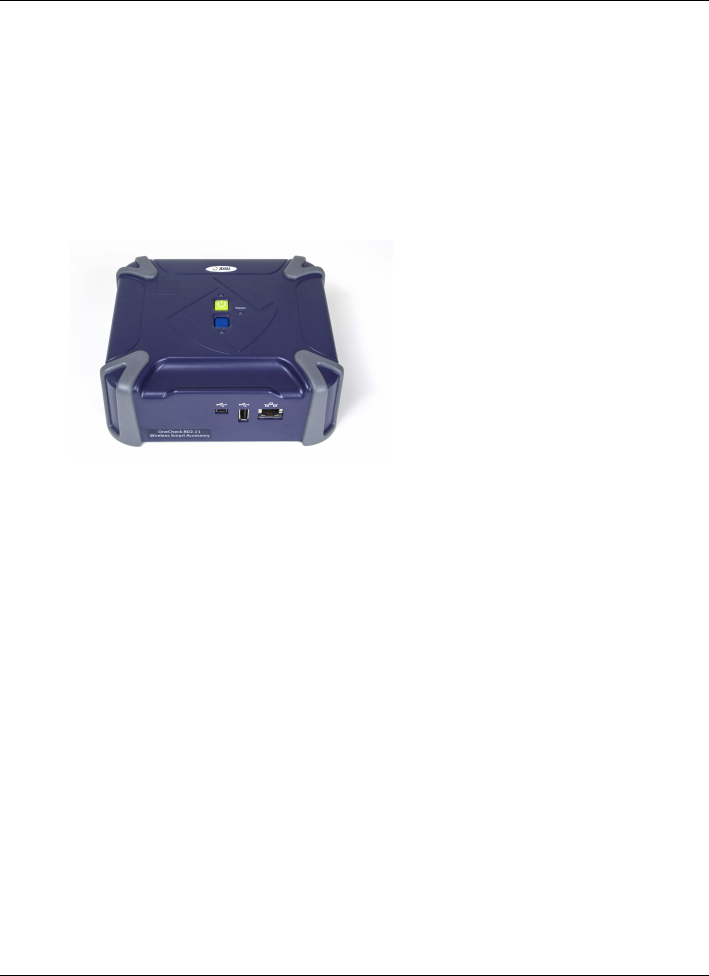
Chapter 1 WiFi Advisor Overview
About the WiFi Advisor
WiFi Advisor Wireless LAN Analyzer User’s Guide
December 2014 22073751, Rev. 002 Page 3
About the WiFi Advisor
The WiFi Advisor, shown in Figure 1, is a portable WiFi analysis solution that effi-
ciently optimizes and troubleshoots 802.11 WiFi networks, provides a whole-home
view of real WiFi performance / margin, and generates valuable information that
can be given to the end user.
Features and capabilities
•Flexible
– Battery powered WFED, configurable as Station or AP
– Configurable radio from 802.11b/g to 802.11ac 3x3
– WiFi and Ethernet test interfaces
•WiFi Advisor hardware:
– 802.11a/b/g/n/ac, 3x3 (Broadcom 43460 chipset)
– Built-in Spectrum Analyzer
– User configurable as either Test Station or Test AP
– 450 MBit/s packet processing engine
– WiFi and Ethernet test I/F’s
– Battery powered
Figure 1 The WiFi Advisor
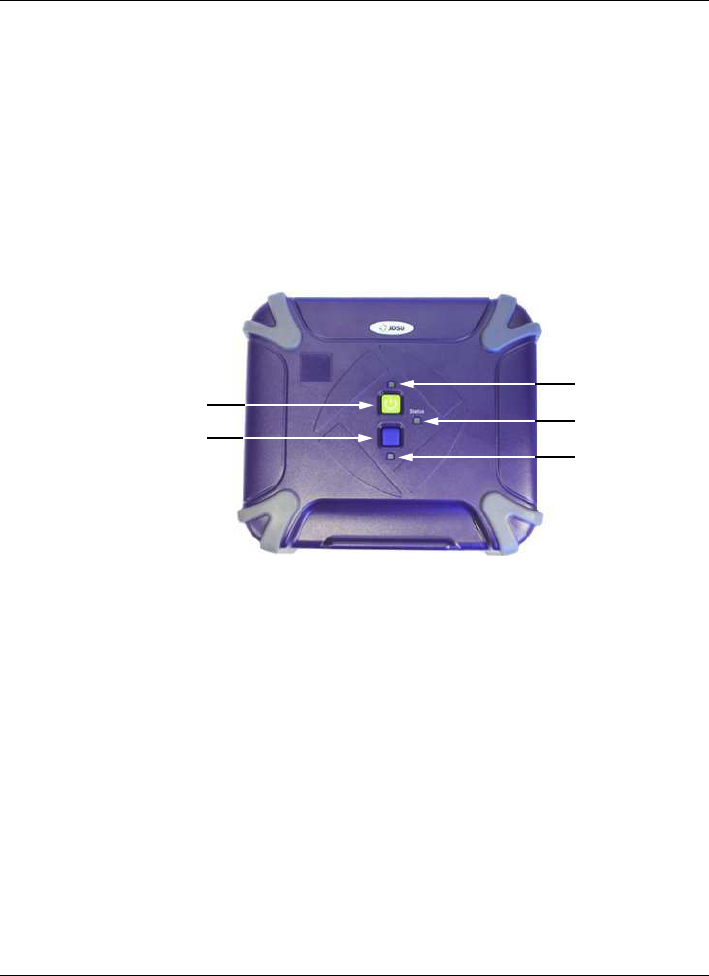
Chapter 1 WiFi Advisor Overview
About the WiFi Advisor
WiFi Advisor Wireless LAN Analyzer User’s Guide
Page 4 22073751, Rev. 002 December 2014
Quick tour
This section describes the buttons, indicators, and connectors for the WiFi Advisor
WFED-300AC.
Top view
The top view is shown in Figure 2.
Power
The power button is the green button on the top of the instrument. Press and hold
the button to power up or power down the instrument.
When the unit is powered up, the LED just above the button indicates the battery
status.
•Solid green indicates the battery has greater than 10% charge or that the
power adapter is plugged in
•Solid red indicates low battery, under 10% charge
•Flashing red indicates the battery is too low to start
•Flashing amber indicates shutting down
•Solid amber indicates the instrument “cannot talk to the battery” so it doesn’t
know the charge level
Figure 2 WiFi Advisor top view
Power LED
Status LED
Bluetooth LED
Power Button
Bluetooth Button

Chapter 1 WiFi Advisor Overview
About the WiFi Advisor
WiFi Advisor Wireless LAN Analyzer User’s Guide
December 2014 22073751, Rev. 002 Page 5
Bluetooth
The Bluetooth button is the blue button on the top of the instrument. Press and hold
the button for five seconds to make the WiFi Advisor ready to pair.
The LED located below the button indicates the Bluetooth status.
•Slow blinking blue (a short on every few seconds) indicates the instrument is
trying to connect over Bluetooth
•Blinking blue (on but short off every few seconds) indicates the instrument is
connected to the iPad but not currently being used
•Solid blue indicates the instrument is connected to the iPad and is being
used by the iPad
Status
The Status LED indicates the status of the test.
•Blinking amber indicates a test is in progress at that location
•Solid green indicates the test is complete at that location and the test passed
•Solid red indicates the test is complete at that location and the test failed
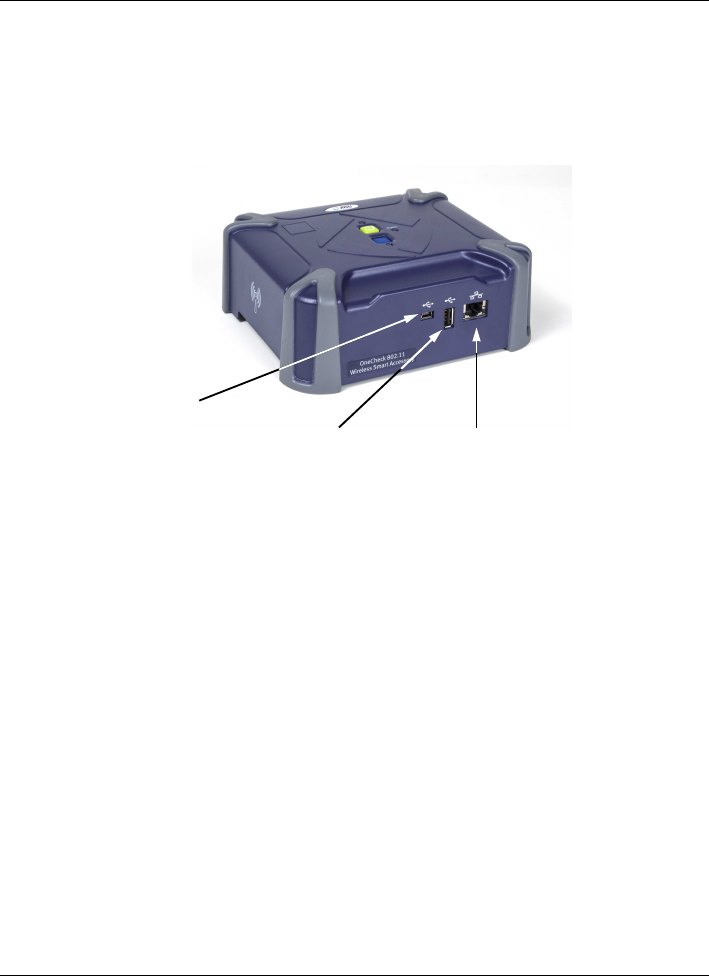
Chapter 1 WiFi Advisor Overview
About the WiFi Advisor
WiFi Advisor Wireless LAN Analyzer User’s Guide
Page 6 22073751, Rev. 002 December 2014
Front view
The front view is shown in Figure 3.
USB
There are two USB connectors. They are used to connect host devices to the WiFi
Advisor and as an alternative path for firmware download.
•The standard USB connector is a master/host interface.
•The mini-USB is a device/slave interface.
Ethernet
The RJ-45 connector interface is reserved for future Ethernet measurement func-
tions.
Figure 3 WiFi Advisor front view
USB 2.0 device
10/100/1000 Ethernet
USB 2.0 host
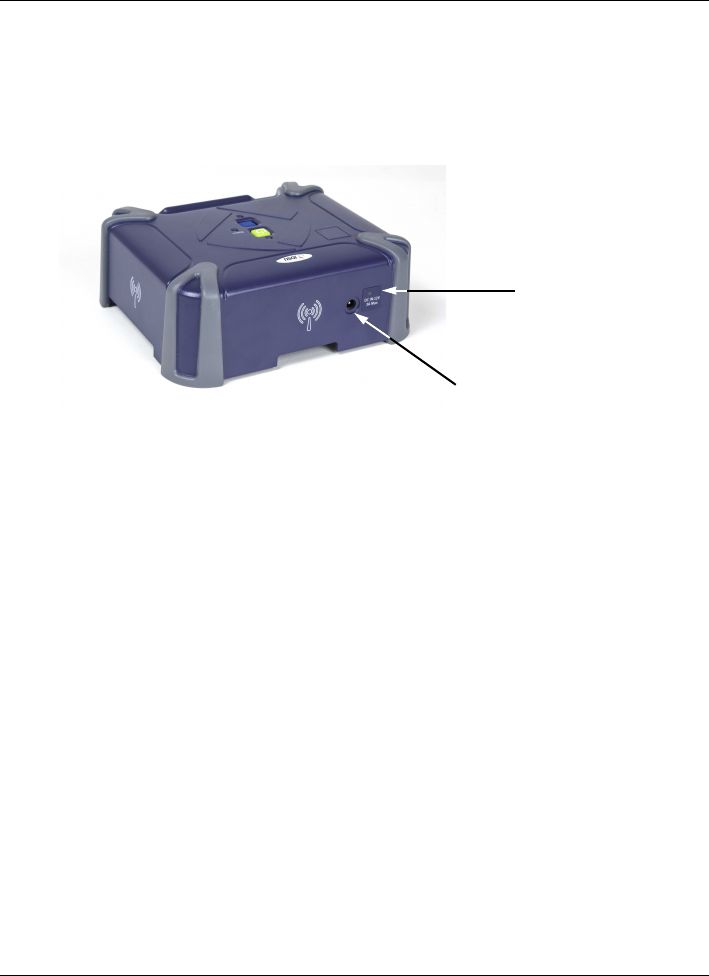
Chapter 1 WiFi Advisor Overview
About the WiFi Advisor
WiFi Advisor Wireless LAN Analyzer User’s Guide
December 2014 22073751, Rev. 002 Page 7
Back view
The back view is shown in Figure 4.
DC Power input
The DC Power input, located on the back of the instrument, is used to connect the
AC adapter.
Battery charge LED
The LED located next to the power input indicates that the adapter is connected.
Red indicates the battery is charging; green indicates fully charged.
Figure 4 WiFi Advisor back view
Battery charge LED
DC Power input
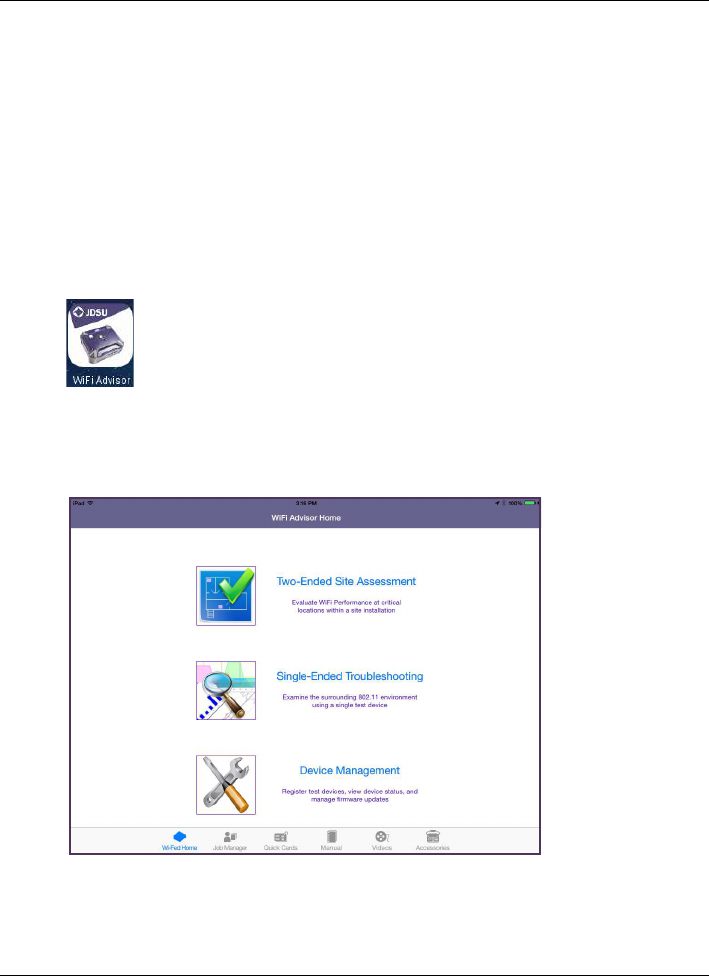
Chapter 1 WiFi Advisor Overview
About the WiFi Advisor app
WiFi Advisor Wireless LAN Analyzer User’s Guide
Page 8 22073751, Rev. 002 December 2014
About the WiFi Advisor app
The WiFi Advisor iPad host app communicates with the WiFi Advisor instrument to
run tests and manage devices. The application allows the user to set up WiFi tests,
communicates test setups to the WFED-300AC WiFi Advisor test device(s) over
Bluetooth, manages test execution, displays test results, and enables administra-
tion of job or work ticket related information.
The icon for the WiFi Advisor is shown in Figure 5. To launch the app, tap the icon.
The Home screen appears, as shown in Figure 6.
Figure 5 WiFi Advisor iPad app icon
Figure 6 WiFi Advisor app Home screen

Chapter 1 WiFi Advisor Overview
About the WiFi Advisor app
WiFi Advisor Wireless LAN Analyzer User’s Guide
December 2014 22073751, Rev. 002 Page 9
The application provides the following functions:
• WiFi Advisor Home – The main application that includes three selections:
– Two-Ended Site Assessment
(Evaluate WiFi performance at critical locations within a site installation)
see “Assessing WiFi performance throughout a site” in
Chapter 3 “Testing”.
– Single-Ended Troubleshooting
(examine the surrounding 802.11 environment using a single test device)
see “WiFi Troubleshooting” in Chapter 3 “Testing”.
– Device Management
(used to register devices, view device status, and manage firmware
updates) see Chapter 2 “Managing Devices”.
To launch an application, either touch the icon or touch the title (for example,
touch the magnifying glass or touch “Single-Ended Troubleshooting”).
• Job Manager – For viewing and uploading of completed job files and
customer PDF reports.
• Quick Cards – The WiFi Advisor Quick Start Guide and other helpful mate-
rial.
• Manual – The WiFi Advisor User’s Guide
• Videos – Short videos describing “How-to” test with the WiFi Advisor
• Accessories – WiFi Advisor Accessory Guide

Chapter 1 WiFi Advisor Overview
About the WiFi Advisor app
WiFi Advisor Wireless LAN Analyzer User’s Guide
Page 10 22073751, Rev. 002 December 2014

2
WiFi Advisor Wireless LAN Analyzer User’s Guide
December 2014 22073751, Rev. 002 Page 11
Chapte r 2
Managing Devices
This chapter describes the Device Management menu which is used to register
devices, view device status, and manage firmware updates. Topics discussed in
this chapter include the following:
•“Connecting a WiFi Advisor for the first time” on page 12
•“Registering and unregistering devices” on page 12
•“Changing the power off delay” on page 13
•“Updating the firmware” on page 14
•“Updating the iPad application software” on page 15

Chapter 2 Managing Devices
Connecting a WiFi Advisor for the first time
WiFi Advisor Wireless LAN Analyzer User’s Guide
Page 12 22073751, Rev. 002 December 2014
Connecting a WiFi Advisor for the first time
Before any testing can begin, each WiFi Advisor must be paired with the iPad.
Pairing devices
1 On the iPad, select the Settings icon.
2 Verify that Bluetooth is set to On.
In the Devices section, the iPad detects and lists any devices within range.
3 Press and hold the blue button on the top of the WiFi Advisor for 5 seconds.
4 Verify that the blue LED on the WiFi Advisor is flashing slowly.
5 On the iPad, in the list of “My Devices”, select the WiFi Advisor with the serial
number of your WiFi Advisor.
6 Label your WiFi Advisor with the letter designator of your choice from the
sheet of ID Labels provided.
This label will be used during the registration process to provide a simple
method to identify test devices for use in the iOS application
When pairing is complete, the status of the WiFi Advisor(s) indicates “Connected”.
Registering and unregistering devices
After pairing the device(s) with the iPad, they must be registered with the WiFi
Advisor app, especially if this is the first time using this WiFi Advisor with this iPad.
To register WiFi Advisor devices with the iPad
1 From the WiFi Advisor app, select Device Management.
2 In the Unregistered Devices area, select the WiFi Advisor with the serial
number of your device.
3 Enter the label letter for the WiFi Advisor.
4 Repeat step 2 and step 3 for each WiFi Advisor.
The registered devices appear in the Device Manager screen.

Chapter 2 Managing Devices
Changing the power off delay
WiFi Advisor Wireless LAN Analyzer User’s Guide
December 2014 22073751, Rev. 002 Page 13
To unregister WiFi Advisor devices with the iPad
1 From the WiFi Advisor app, select Device Management.
2 Select the WiFi Advisor with the label (or serial number) of your device and
swipe to the left.
A red Delete button appears.
3 Do one of the following:
– If you do not wish to unregister the device, swipe to the right.
– Tap the Delete button to unregister your device.
Changing the power off delay
The power off delay values associated with each registered WiFi Advisor are shown
within the Registered Devices section of the Device Manager screen. These values
define the amount of idle time that must transpire before the test device will auto-
matically power down.
To change the power off delay for a WiFi Advisor
1 From the WiFi Advisor app, select Device Management.
2 Touch the Power Off Delay associated with that WiFi Advisor.
3 Select the power off delay.
Disable means it will not automatically power down regardless of expired
time.
If you would like to dismiss the window without changing the current setting,
touch outside of the window.
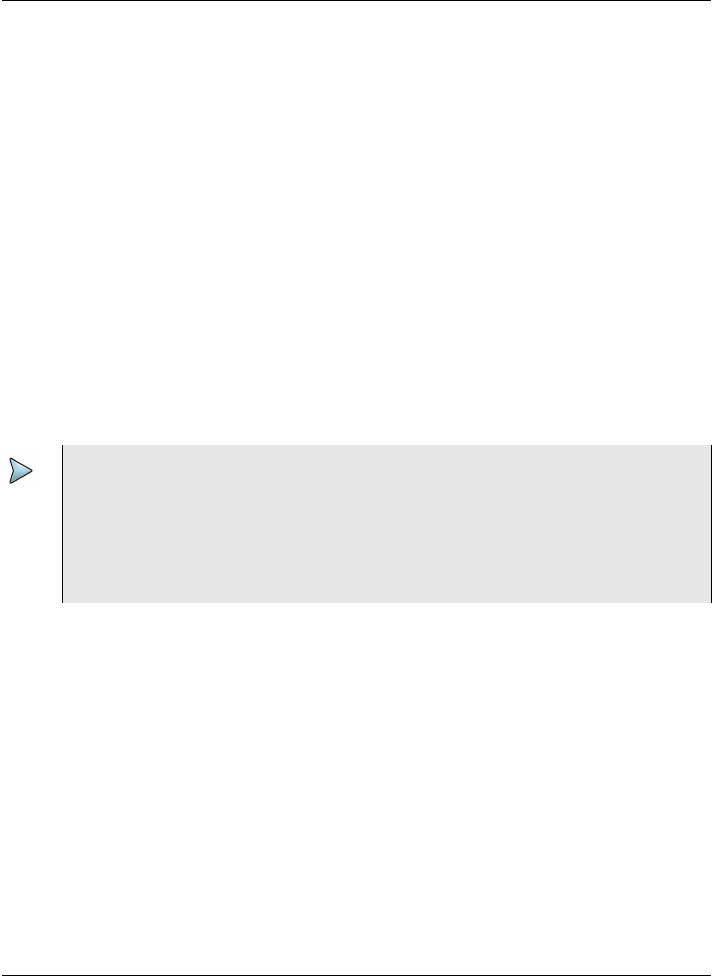
Chapter 2 Managing Devices
Updating the firmware
WiFi Advisor Wireless LAN Analyzer User’s Guide
Page 14 22073751, Rev. 002 December 2014
Updating the firmware
The firmware on the WiFi Advisor can be upgraded over Bluetooth using the iPad.
The WiFi Advisor must be paired with the iPad and registered with the app.
To update firmware on a registered WiFi Advisor
1 In the WiFi Advisor app, select Device Management.
The menu reports all registered WiFi Advisor devices and the current firm-
ware for each.
2 Find the WiFi Advisor you wish to update, and click on icon of the device with
a down arrow.
3 A confirmation screen appears.
4 Select Yes.
The update begins. The status bar at the top indicates the update progress.
NOTE:
If you experience trouble, look at the number of Bluetooth devices in the area. Three
to four devices is a practical limit, depending on the types of devices and profiles
used. Some devices require more Bluetooth data, so they are more demanding than
other devices. Data-intensive devices may reduce the total number of devices that
can be active at the same time. If a Bluetooth device becomes slow to connect or
does not perform reliably, reduce the total number of connected devices.

Chapter 2 Managing Devices
Updating the iPad application software
WiFi Advisor Wireless LAN Analyzer User’s Guide
December 2014 22073751, Rev. 002 Page 15
Updating the iPad application software
Updating the iPad host application software allows you to have the latest applica-
tion, including new WiFi Advisor features and company-specific procedures or
applications.
To update the host application software
1 To download the app, do one of the following:
a If your company has an enterprise network, connect to your company
enterprise network with the iPad. If there is a new version, your app icon
will include a badge (a circle in the upper corner that indicates updates
are available). Using the browser, go to the site/location where the appli-
cation is kept, then download the new version.
b Go to the Apple App Store.
2 As the process runs, the app icon has a circle inside that rotates.
3 When the update is finished, the rotating circle disappears and the icon has a
“badge” (a blue dot in the upper left).
The host application software is updated.

Chapter 2 Managing Devices
Updating the iPad application software
WiFi Advisor Wireless LAN Analyzer User’s Guide
Page 16 22073751, Rev. 002 December 2014

3
WiFi Advisor Wireless LAN Analyzer User’s Guide
December 2014 22073751, Rev. 002 Page 17
Chapte r 3
Testing
This chapter provides task-based instructions for using the WiFi Advisor features.
Topics discussed in this chapter are as follows:
•“WiFi Troubleshooting” on page 18
•“Assessing WiFi performance throughout a site” on page 25
•“Managing jobs” on page 35
•“Troubleshooting Problems with Your WiFi Advisor” on page 41

Chapter 3 Testing
WiFi Troubleshooting
WiFi Advisor Wireless LAN Analyzer User’s Guide
Page 18 22073751, Rev. 002 December 2014
WiFi Troubleshooting
The single-ended troubleshooting test includes the following:
•Quick, visually intuitive assessment of critical WiFi network factors reduces
troubleshooting time
•Spectral insight within the same tool allows identification and isolation of
common, non-802.11 interferers
•Expert recommendations helps minimize the time spent to effectively opti-
mize the network and reduces likelihood of repeat calls
The following procedure describes how to troubleshoot a single connection on a
network.This test is typically run if the service is not working properly.
To troubleshoot a single connection
1 Bring the iPad and WiFi Advisor to the location experiencing problems.
2 Open the app on the iPad.
3 Select Single-Ended Troubleshooting.
4 Choose which WiFi Advisor device to use for the test.
If you have previously used a WiFi Advisor device with this iPad, it appears in
the list of devices. If it does not appear, you may need to register the device
with the iPad and pair to it. See “Connecting a WiFi Advisor for the first time”
on page 12 and “Registering and unregistering devices” on page 12.
5 Select a result tab at the top: BSSID, Channel, or Spectral.
BSSID results
The BSSID results provide quick visibility into the wireless networks active in the
current environment in both the 2.4GHz and 5GHz WiFi bands. The BSSID results
report the RSSI per channel. A sample result is shown in Figure 7
.
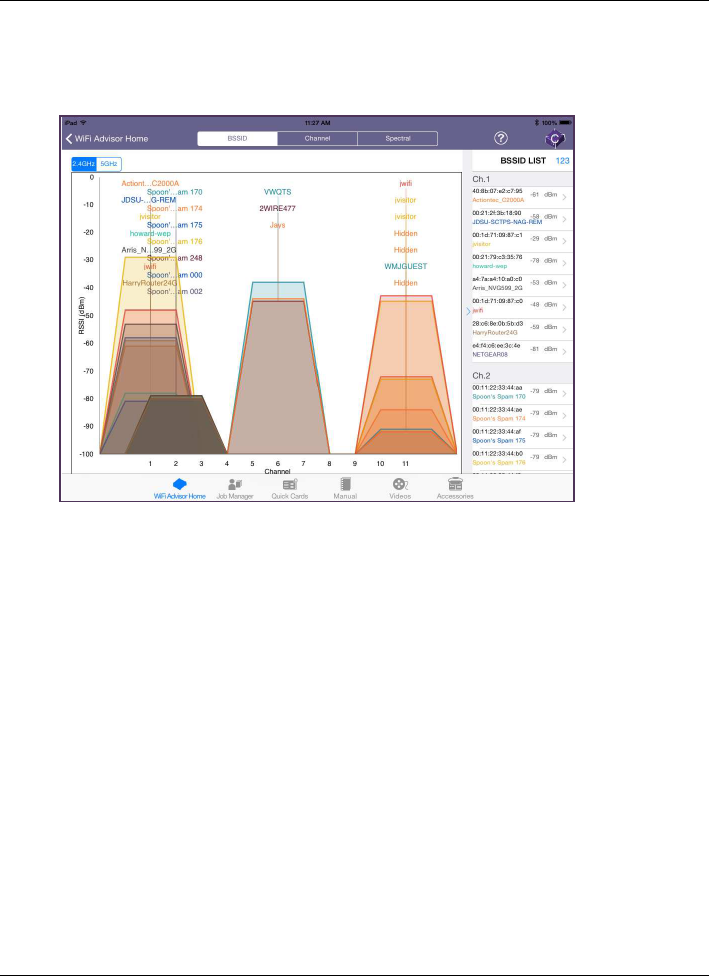
Chapter 3 Testing
WiFi Troubleshooting
WiFi Advisor Wireless LAN Analyzer User’s Guide
December 2014 22073751, Rev. 002 Page 19
This provides a visual representation of overlap in the channels to help identify
problem spots.
The BSSID graph area shows each visible BSSID by channel and signal strength.
This view is useful for understanding an existing Access Point’s channel configura-
tion and signal strength or for determining which channel to select for a new AP to
be placed within the environment.
To toggle between 2.4GHz band and 5GHz band, touch the band toggle switch in
the upper left of the graph.
The BSSID List view in the right pane provides a listing of all detected BSSIDs along
with their channel setting, current signal strength, and MAC address. To change the
order of the list, tap 123 (sort by channel) or ABC (sort by name). To view more
details of a particular BSSID, touch the desired BSSID.
From the BSSID Details menu, touch Trend Graphs. Trend graphs show RSSI,
Noise, and Channel Utilization over time for the selected BSSID. A sample graph is
Figure 7 BSSID results
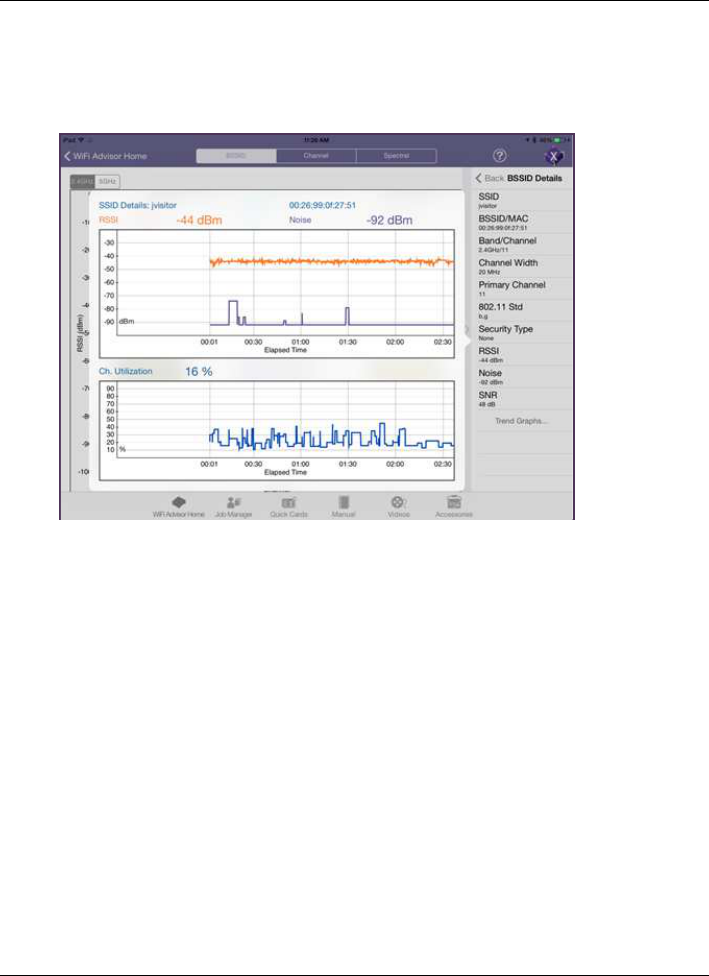
Chapter 3 Testing
WiFi Troubleshooting
WiFi Advisor Wireless LAN Analyzer User’s Guide
Page 20 22073751, Rev. 002 December 2014
shown in Figure 8.
Channel view
The Channel view, shown in Figure 9, shows utilization and noise per 802.11
channel in addition to co-channel or adjacent channel interferers. You can view the
best channels per band, best channels per channel width, or overall channel score.
This allows you to select the best channels available in the current environment.
Figure 8 Trend Graphs
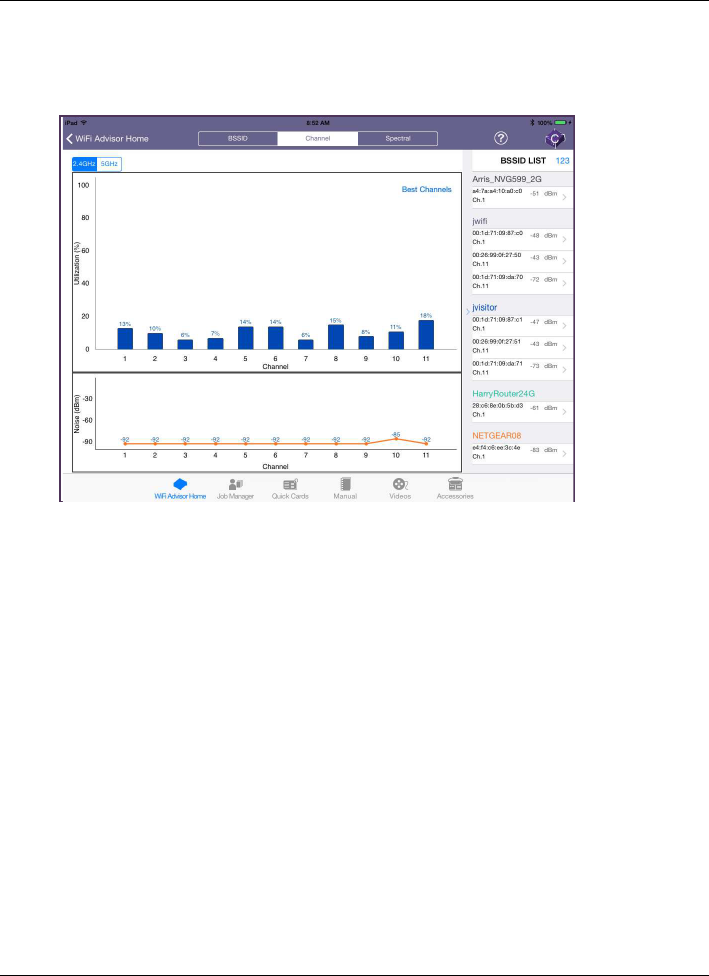
Chapter 3 Testing
WiFi Troubleshooting
WiFi Advisor Wireless LAN Analyzer User’s Guide
December 2014 22073751, Rev. 002 Page 21
The Utilization graph in the top pane shows the channel utilization for all channels
in the selected band. Touching a bar within the graph highlights the bar for that
channel (the blue bar will turn green) and the “BSSID List” changes to the Channel
Summary which includes values associated with that particular channel.
The Noise graph in the bottom pane displays the noise per channel.
Touching the band toggle switch in the upper left of the graph toggles between
2.4GHz band and 5GHz band views.
As in the BSSID view, the BSSID List view in the right pane provides a listing of all
detected BSSIDs along with their channel setting, current signal strength, and MAC
address. To change the order of the list, tap 123 (sort by channel) or ABC (sort by
name).
Touching a specific BSSID from the BSSID list configures the Utilization bar graph
to the channel associated with that particular BSSID and the “BSSID List” changes
to the Channel Details view in the right hand pane. Touching a specific bar in the
Utilization graph also changes the BSSID List view to the Channel Details for that
Figure 9 Channel results
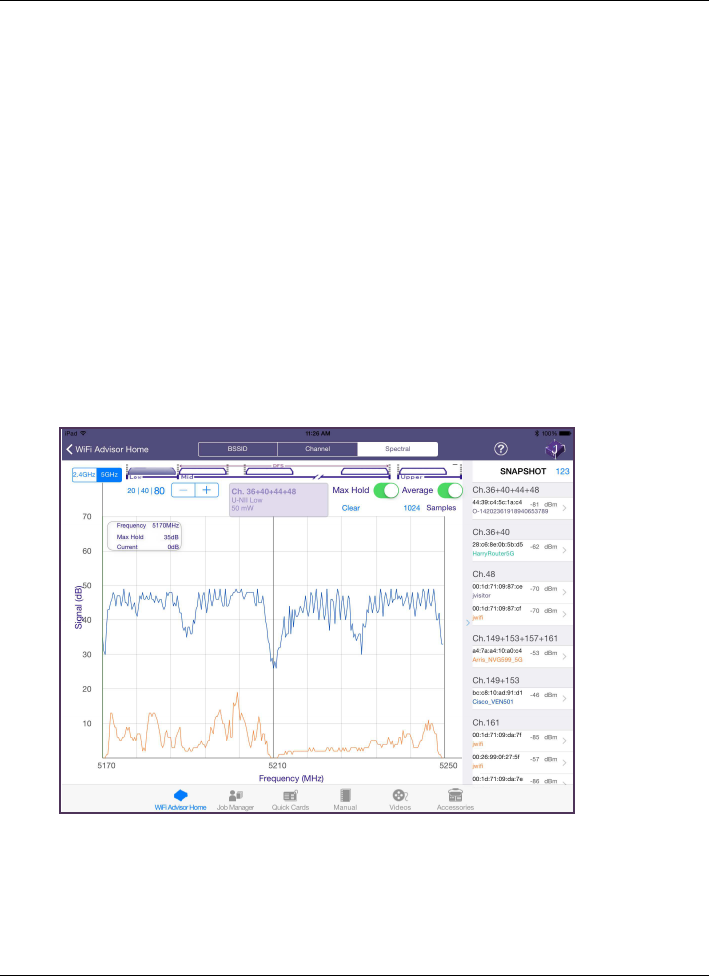
Chapter 3 Testing
WiFi Troubleshooting
WiFi Advisor Wireless LAN Analyzer User’s Guide
Page 22 22073751, Rev. 002 December 2014
particular channel which includes the channel score, the channel utilization, noise,
the BSSIDs resident in the channel, and the BSSIDs that are overlapping (adjacent
to) that channel.
Touching Best Channels in the top right area of the Utilization graph displays a
table that identifies the current top 3 best channels based on channel width for the
band being viewed. Touching anywhere on the screen closes the table.
Spectral results
The Spectral results, shown in Figure 10, provides a real-time spectral analyzer
configurable by 802.11 band, channel, and channel width. It is helpful for finding
signals that interfere with 802.11 networks by showing both 802.11 and non-802.11
RF signals within a given channel of interest.
Figure 10 Spectral results

Chapter 3 Testing
WiFi Troubleshooting
WiFi Advisor Wireless LAN Analyzer User’s Guide
December 2014 22073751, Rev. 002 Page 23
The Spectral results screen has 3 main areas:
•The spectral graph area, where the real-time spectral data is displayed
•The controls area, where the user can configure the spectrum analyzer
ranges and modes
•The BSSID List / Channel information pane
Navigating the Spectral result screen
As in the BSSID and Channel views, the BSSID List view in the right pane provides
a listing of all detected BSSIDs along with their channel setting, current signal
strength, and MAC address. To change the order of the list, tap 123 (sort by
channel) or ABC (sort by name). The BSSID list is not continuously updated while
spectral data is being displayed and is therefore labeled as SNAPSHOT as it repre-
sents a list of BSSIDs gathered over a finite period of time prior to turning on the
Spectral Analyzer.
Touching a specific BSSID from the BSSID Snapshot List configures the Spectrum
Analyzer to the channel(s) associated with the BSSID selected, and changes the
BSSID Snapshot view in the right pane to the Channel Details for that particular
channel which includes the channel score, the channel utilization, noise, the
BSSIDs resident in the channel, and the BSSIDs that are overlapping (adjacent to)
that channel. NOTE: This data is a snapshot. Live data may vary slightly.
The Spectrum Analyzer controls, located across the top of the graph, consist of the
following:
1Band toggle switch – selects 2.4GHz or 5GHz bands for analysis
2Channel bandwidth selector – selects the width of the spectrum analyzer:
– 20MHz
– 40Hz, or
– 80MHz (5GHz band only)
3Channel up (+) or down (-) – touch to increment or decrement the 802.11
channel(s) being analyzed
4Max Hold – turns the Max Hold trace on the spectral graph on or off. When
Max Hold is on, a blue line appears above the standard spectral line that
represents the peak value (in dBm) seen at each frequency point.

Chapter 3 Testing
WiFi Troubleshooting
WiFi Advisor Wireless LAN Analyzer User’s Guide
Page 24 22073751, Rev. 002 December 2014
5Clear – located under Max Hold, it resets the Max Hold trace and restarts the
measurement.
6Average – allows averaging of the real-time trace when on
7Number of Samples – select the number of samples to be used for averaging
of the real-time trace
8World view – shows all channels. Changing the channel bandwidth changes
how channels are represented in the world view.
To insert a vertical cursor within the real-time spectral plot, touch the graph where
the cursor position is desired. The cursor readout box in the upper left reports the
frequency at that position, in addition to the real-time and max hold signal levels at
that frequency. The cursor can be moved by tapping anywhere on the graph within
the channel width. By default, a cursor is located at the left edge of the view.
Troubleshooting Spectral measurements
The following are some common interferers that could show up in a spectral
measurement.
Microwave ovens can interfere with an 802.11 signal. They are most prevalent in
channels 10 and 11. If possible, it is a good idea to look at the spectral response
while the microwave is running to determine it’s impact.
Bluetooth devices appear as spikes and appear to “roll” through the spectral view.
They are fast moving and you may only see them occasionally. The systems are
designed to be interoperable, but Bluetooth will impact throughput.
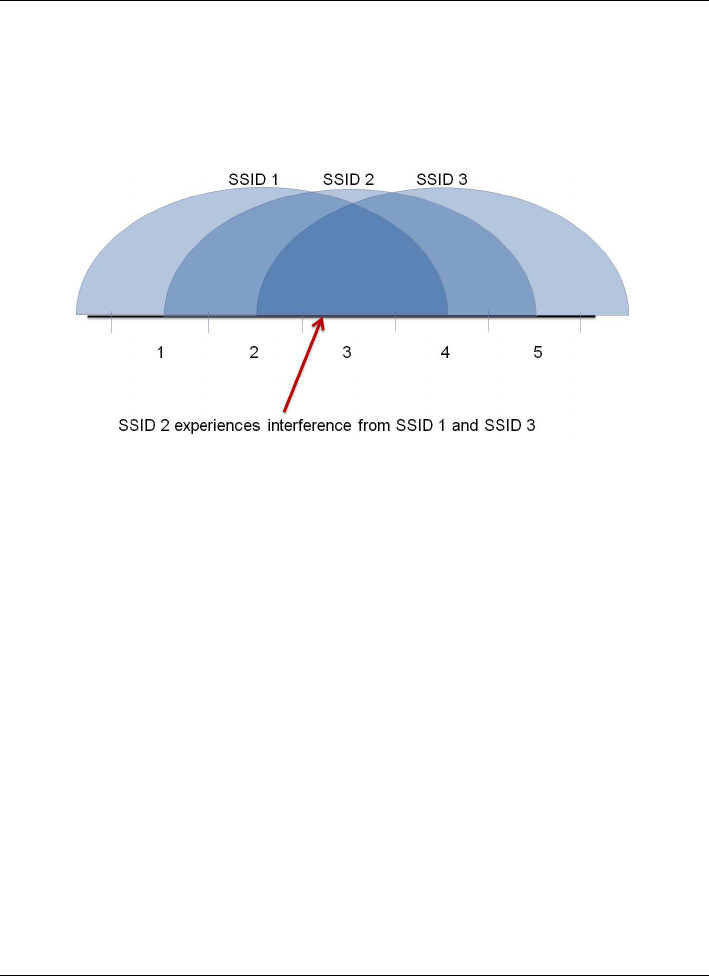
Chapter 3 Testing
Assessing WiFi performance throughout a site
WiFi Advisor Wireless LAN Analyzer User’s Guide
December 2014 22073751, Rev. 002 Page 25
Channels can “bleed over” into adjacent channels. The width of the signal (due to
RF considerations) can affect nearby channels, as shown in Figure 11.
Assessing WiFi performance throughout a site
The general procedure for a Site Assessment test is:
1 Place one WiFi Advisor in close proximity to where the Wireless Access
Point (or Residential Gateway) will be installed.
2 Take a second WiFi Advisor along with your iPad to the location where WiFi
performance is to be assessed. The test thoroughly evaluates WiFi perfor-
mance between the two locations.
3 Move to the next location of interest and repeat the test to the Access Point.
4 Continue until all locations of interest have been performance tested.
5 If desired, the test results are saved to the active job or work ticket or associ-
ated with a new job. (See the “Managing jobs” section for more details
regarding work flow with job / tickets).
The two-ended site assessment test includes the following features:
Figure 11 Spectral view of channel overlap

Chapter 3 Testing
Assessing WiFi performance throughout a site
WiFi Advisor Wireless LAN Analyzer User’s Guide
Page 26 22073751, Rev. 002 December 2014
•Innovative TrueMargin™ performance test which thoroughly and simultane-
ously evaluates the physical layer, the 802.11 transport layer and the packet
layer.
•BSSID / AP view snapshot for each test location
•Spectral snapshots at both ends of the wireless link
•Best Channel recommendations for 2.4G / 5G for the given test profile
•Ability to evaluate WiFi performance at multiple locations within the home
•WiFi Network Optimization recommendations
Getting started
In order to get started with site assessment test, you must have two registered WiFi
Advisors connected over Bluetooth.
To get started
1 Launch the WiFi Advisor app.
2 Select Two-Ended Site Assessment.
Specifying settings
During Site Assessment test, up to five individual test profiles are configured that
are repeated at each location. The test profiles run sequentially at each location,
and always in the same order. Each Site Assessment configuration has a Primary
Profile, with up to four additional profiles, known as Secondary Profiles. Only the
Primary Profile is associated with Pass/Fail or Closeout testing. The Secondary
Profiles are informational, rather than Pass/Fail. At the beginning of the Site
Assessment, the Secondary Profiles can be enabled or disabled as a group. This
allows for rapid Site Assessment testing if only the Primary Profile is desired.
Step 1: Selecting devices
The first setting to specify is selecting which device is the access point and which
is the station.

Chapter 3 Testing
Assessing WiFi performance throughout a site
WiFi Advisor Wireless LAN Analyzer User’s Guide
December 2014 22073751, Rev. 002 Page 27
To select devices
1 From the Site Assessment page, select Devices.
All registered devices are shown.
If not shown, you may need to pair with the device and then register it. See
“Connecting a WiFi Advisor for the first time” on page 12 and “Registering
and unregistering devices” on page 12.
2 Choose an AP (access point) Location.
3 Select a Station Location.
The Access Point device generally stays in one location (the desired location for the
actual Access Point / Residential Gateway) and the Station device typically travels
from test location to test location.
Step 2: Specifying the Broadband Service Rate
This setting specifies the broadband service rate that the customer is receiving from
their internet provider. If not specified (left blank), the setting is ignored.
To specify the Broadband Service Rate
1 From the Site Assessment page, select Broadband Service.
2 Enter the rate in MBit/s.
NOTE:
If you experience trouble, look at the number of Bluetooth devices in the area. Three
to four devices is a practical limit, depending on the types of devices and profiles
used. Some devices require more Bluetooth data, so they are more demanding than
other devices. Data-intensive devices may reduce the total number of devices that
can be active at the same time. If a Bluetooth device becomes slow to connect or
does not perform reliably, reduce the total number of connected devices.
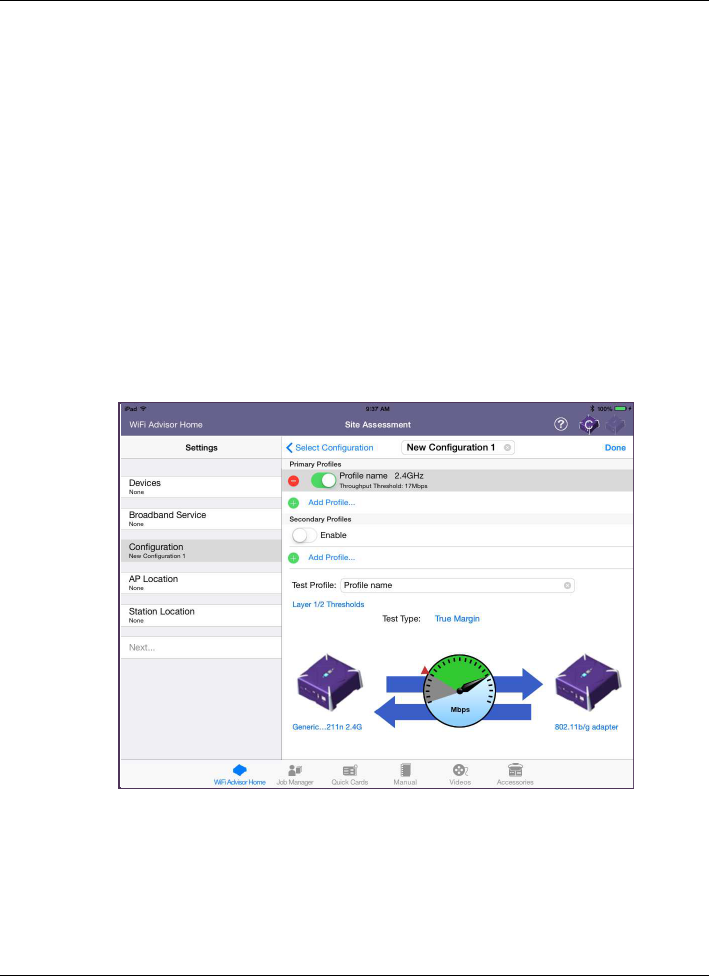
Chapter 3 Testing
Assessing WiFi performance throughout a site
WiFi Advisor Wireless LAN Analyzer User’s Guide
Page 28 22073751, Rev. 002 December 2014
Step 3: Specifying the configuration
The configuration page specifies the profile(s).
To specify a configuration
1 From the Site Assessment page, select Configuration.
2 Do one of the following:
– Select the pre-defined configuration that matches your needs or matches
the equipment you are installing into the test site. Proceed to “Step 4:
Specifying the AP and Station Location” on page 30.
– If no pre-defined configuration matches your needs, touch Add Configu-
ration.
The New Configuration page appears.
3 In the box at the top, specify a name for the configuration.
At the bottom, a graphical representation of the network appears.

Chapter 3 Testing
Assessing WiFi performance throughout a site
WiFi Advisor Wireless LAN Analyzer User’s Guide
December 2014 22073751, Rev. 002 Page 29
4 If you wish to change the profile, do the following:
a In the Test Profile box, just above the network graphic, enter a name for
the profile.
b Touch the instrument graphic on the left to specify the device that is oper-
ating as the access point.
i Do one of the following:
- Select from the pre-defined devices that is operating as the access
point.
- If no pre-defined configuration matches your needs, touch Add AP
Device.
ii Specify settings for the device, such as standard, band, channel
width, number of antennas, and other configuration items.
c Touch the instrument graphic on the right and specify the device that is
operating as the Station.
i Do one of the following:
- Select from the pre-defined devices that is operating as the access
point.
- If no pre-defined configuration matches your needs, touch Add
Station Device.
ii Specify settings for the device, such as name, standard, number of
antennas, and other configuration items.
d Just above the instrument graphic on the left, select Layer 1/2 Thresh-
olds.
i Specify the Layer 1 Thresholds for RSSI, Noise, count of BSSID’s
on a Channel, and count of BSSID’s with Overlapping Channels.
ii Specify the Tx Failures, Retransmits, PHY rate, and Service
Threshold for the 802.11 Thresholds.
iii Touch the back arrow to return to the new configuration page.
5 If you wish to specify another Primary Profile, touch Add Profile located
under Primary Profiles.
6 If you wish to include a Secondary Profile, move the button to Enable and
follow step 4 above.

Chapter 3 Testing
Assessing WiFi performance throughout a site
WiFi Advisor Wireless LAN Analyzer User’s Guide
Page 30 22073751, Rev. 002 December 2014
7 If you wish to specify an additional secondary profile, touch Add Profile
located under Secondary Profiles.
8 Touch the back arrow to return to the Select Configuration page.
The new configuration is saved and can be selected for future tests.
To delete a configuration
To delete a configuration, touch and hold the configuration until it is highlighted, and
then swipe to the left. A Delete button appears. Tap the Delete button.
Step 4: Specifying the AP and Station Location
These settings specify the room where each WiFi Advisor is located.
To specify the AP and Station location
1 From the Site Assessment page, select AP Location.
2 Select the room where the Access Point is located. If the location you desire
is not listed, select Add Location.
3 From the Site Assessment page, select Station Location.
4 Select the room where the Station is located. If the location you desire is not
listed, select Add Location.
Assessing an installation site
Two-ended site assessment uses two WiFi Advisors to test connectivity and assess
an installation site. The following procedure describes how to assess an installation
site.
To assess an installation site
1 Bring an iPad and two WiFi Advisors to the site.
2 Open the WiFi Advisor app on the iPad.
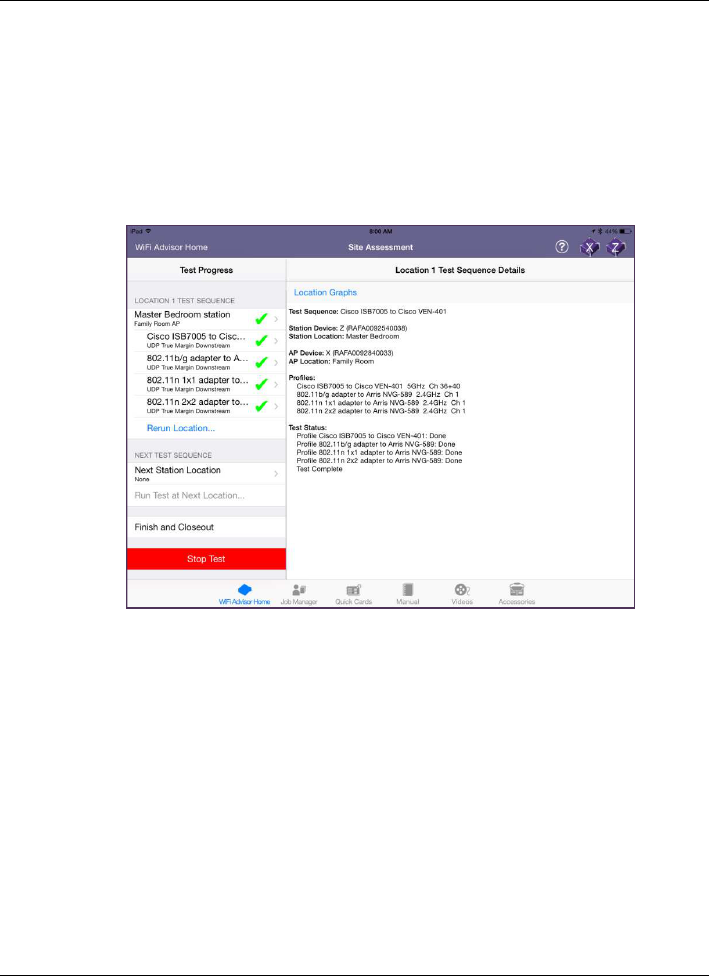
Chapter 3 Testing
Assessing WiFi performance throughout a site
WiFi Advisor Wireless LAN Analyzer User’s Guide
December 2014 22073751, Rev. 002 Page 31
3 Select Two-Ended Site Assessment.
The Settings page appears.
4 If needed, specify the settings as described in “Specifying settings”.
5 Select Next... to initiate the Site Assessment test.
6 After the first location is tested, a green check mark or red “X” (a Go/No Go
result) appears next to the access point and station.
7 If you have another station, select Next Station Location. If not, go to step 8.
The other station must be another WiFi Advisor that is registered with the
App.
8 When finished testing, select Finish and Closeout. The Finish Test window
opens.
9 Enter the Customer Address. This appears in the closeout report.
10 To finish the closeout, save the results to a current job or a new job.
See“Managing jobs” on page 35

Chapter 3 Testing
Assessing WiFi performance throughout a site
WiFi Advisor Wireless LAN Analyzer User’s Guide
Page 32 22073751, Rev. 002 December 2014
Interpreting Site Assessment results
While the Site Assessment test is in progress, results for any completed profile test
can be viewed by touching the completed profile in the Test Progress pane.
When a profile name is selected, the Site Assessment Results screen appears.
This screen displays results for both the AP-to-Station direction and Station-to-AP
direction. The menu has several result views:
• Summary – shows a summary of the throughput and throughput margin
tests for the selected profile. This view includes the TrueMargin™ result to
help understand the resiliency of the WiFi link under test.
• Details – shows the detailed statistics for the selected test profile in tabular
form.
• Histograms – provides histograms of per-packet PHY rate and retransmis-
sion retries.
• Trend Graphs – time correlated view of critical test measurements and
results.
• Spectral – snapshots for the channel used in the test profile. Shown at both
AP and Station.
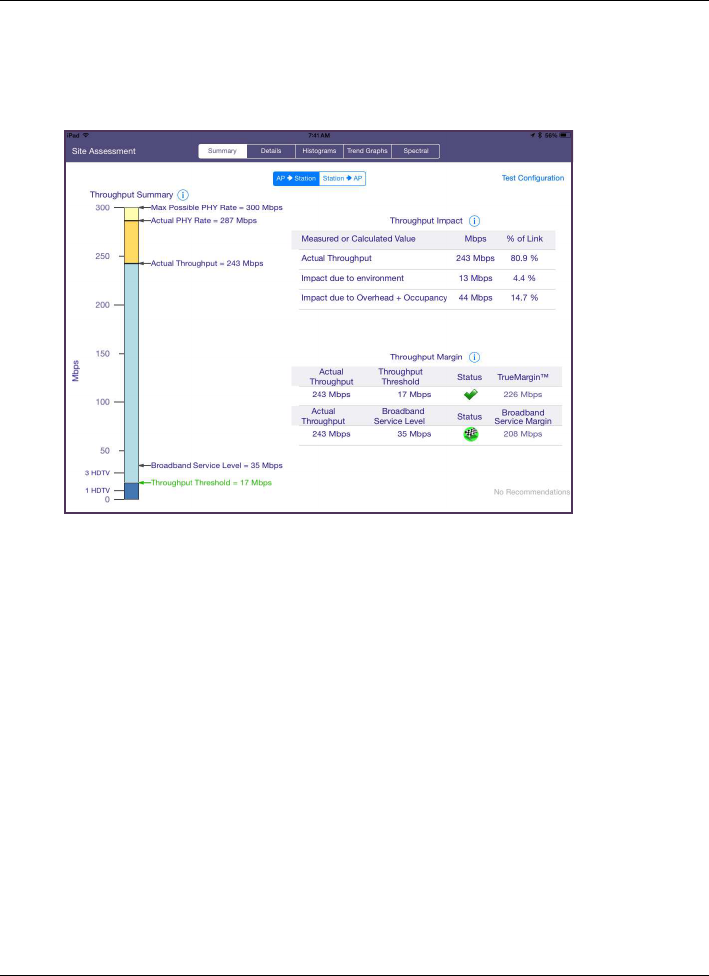
Chapter 3 Testing
Assessing WiFi performance throughout a site
WiFi Advisor Wireless LAN Analyzer User’s Guide
December 2014 22073751, Rev. 002 Page 33
An example of the Summary Results is shown in Figure 12.
To return to the Site Assessment test, touch Site Assessment in the upper left.
Figure 12 Example of Site Assessment Summary Results
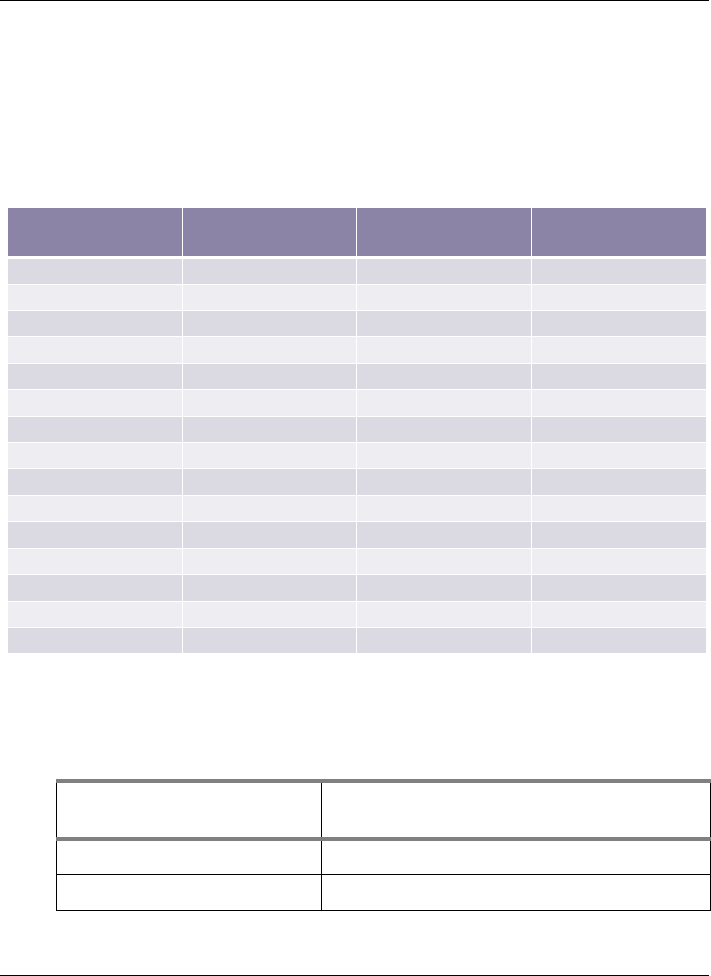
Chapter 3 Testing
Assessing WiFi performance throughout a site
WiFi Advisor Wireless LAN Analyzer User’s Guide
Page 34 22073751, Rev. 002 December 2014
Tips
If the rates you receive are not what you expected, review Figure 13. It provides
maximum rates available based on protocol.
The table below shows the recommended minimum distance between WiFi equip-
ment and household appliances to reduce interference.
Figure 13 Max possible rates per protocol
Protocol Channel BW (MHz) Antenna
Configuration
Max Possible PHY
Rate (Mbps)
802.11a 20 1x1 54
802.11b/g 20 1x1 54
802.11n 20 1x1 72
802.11n 40 1x1 150
802.11n 20 2x2 144
802.11n 40 2x2 300
802.11ac 20 1x1 96
802.11ac 40 1x1 200
802.11ac 80 1x1 433
802.11ac 20 2x2 192
802.11ac 40 2x2 400
802.11ac 80 2x2 866
802.11ac 20 3x3 288
802.11ac 40 3x3 600
802.11ac 80 3x3 1300
Table 4 Recommended WiFi distance
Household Appliance Recommended Minimum Distance
(in feet and meters)
Microwave ovens 30 feet / 9 meters
Baby monitor - Analog 20 feet / 6 meters

Chapter 3 Testing
Managing jobs
WiFi Advisor Wireless LAN Analyzer User’s Guide
December 2014 22073751, Rev. 002 Page 35
Viewing Location Results
At the beginning of each location test, a BSSID graph is captured at both the Station
and the AP, for both 2.4GHz and 5GHz bands. These location graphs apply to all
profile tests at the location and are viewable by first pressing the Location name in
the Test Progress bar to select the location test of interest, and then pressing Loca-
tion Graphs in the top left pane of the Test Sequence window. To return to the Site
Assessment test, touch Site Assessment in the upper left.
Managing jobs
The Job Manager is used to associate test results from a test to a single job. If any
jobs have been saved, they appear in the list. The Job Manager allows you to setup
a new job, edit an active job, activate a job, export a job, or delete a job.
When test results are associated with a job, the jobs are stored on the iPad. The
last 50 jobs are stored; if you have more than 50 jobs, the oldest job is deleted auto-
matically. JDSU recommends that jobs be exported to your external database
before they are automatically deleted.
Baby monitor - Digital 40 feet / 12 meters
Cordless phone - Analog 20 feet / 6 meters
Cordless phone - Digital 30 feet / 9 meters
Bluetooth devices 20 feet / 6 meters
Table 4 Recommended WiFi distance (Continued)
Household Appliance Recommended Minimum Distance
(in feet and meters)

Chapter 3 Testing
Managing jobs
WiFi Advisor Wireless LAN Analyzer User’s Guide
Page 36 22073751, Rev. 002 December 2014
Creating a new job in Job Manager
Within the Job Manager application, you can create a new job.
To create a new job
1 From the main Job Manager screen, touch New.
2 In the Add Job screen, enter the job-related information such as Circuit ID,
Work Ticket, and Tech ID. Touch Use Current Location if your iPad is
equipped with GPS (Geo Tag) and you wish to capture the current GPS coor-
dinates with your job data.
3 Touch Accept to create the new job.
The new job will be visible in the main Job Manager screen as the currently active
job. New jobs are void of results, but once activated, results from a Site Assessment
test can be associated with the job. The page icon with a “0” at the right side indi-
cates that no results have yet been saved to this job. The job is now ready to accept
results from the Site Assessment test as the Active Job.
Saving to a new job in the Site Assessment test
Within the Site Assessment test application, you can save results to a new job.
To save results to a new job
1 After running the test, select Save to New Job.
2 Go to the Job Manager and select the new job. The job details appear.
3 Touch Edit to add the job-related information such as Circuit ID, Work Ticket,
and Tech ID. Touch Use Current Location if your iPad is equipped with GPS
(Geo Tag) and you wish to capture the current GPS coordinates with your job
data.
The new job will be visible in the main Job Manager screen as the currently active
job.

Chapter 3 Testing
Managing jobs
WiFi Advisor Wireless LAN Analyzer User’s Guide
December 2014 22073751, Rev. 002 Page 37
Activating or deactivating jobs
There can be only one Active job at any point in time. Any stored job can be acti-
vated or deactivated. If a job already has results associated with it, activating the
job and saving new results to it will replace the old results with the new.
To activate or deactivate a job
1 From the main Job Manager screen, touch Manage.
Active jobs are listed.
Note that the available options are dependent on which jobs have been
selected for action by checking the job’s corresponding check box on the left
side of the screen.
2 Choose the desired job by selecting the box next to the job.
3 Touch either Activate or Deactivate.
Viewing job results
After running tests, you can view the job details.
To view job results
1 From the main Job Manager screen, touch the job that you are interested in
viewing.
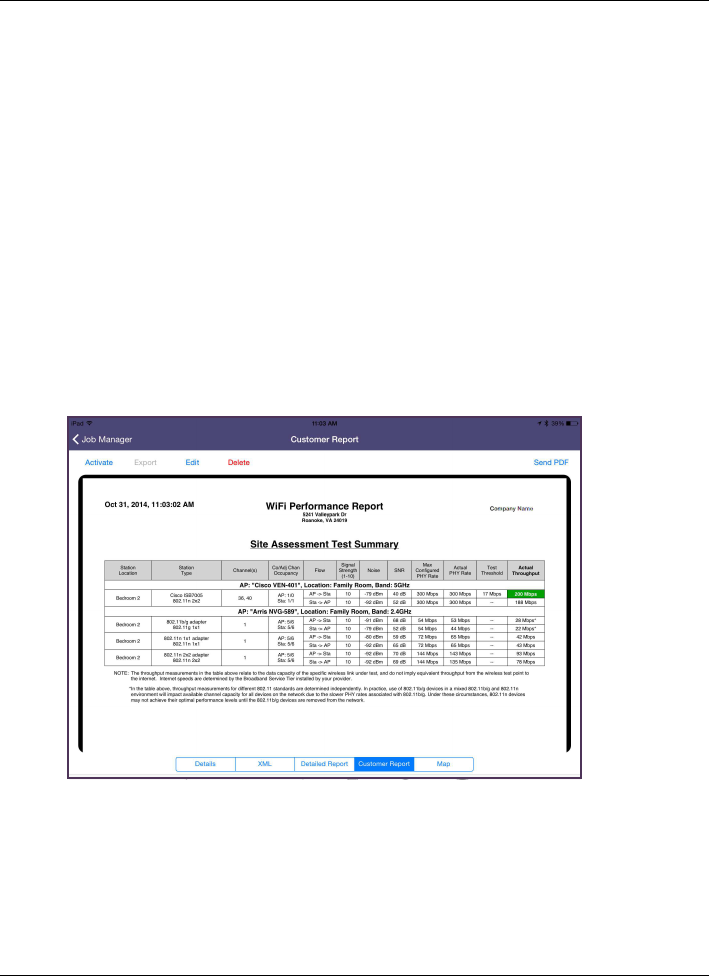
Chapter 3 Testing
Managing jobs
WiFi Advisor Wireless LAN Analyzer User’s Guide
Page 38 22073751, Rev. 002 December 2014
The results can be viewed in several ways.
– XML – shows results gathered in the Site Assessment Test in XML
format.
– Details – shows results gathered in the Site Assessment Test in text
format.
– Detailed Report – shows all results gathered in the Site Assessment Test,
including the graphs, in PDF.
– Customer Report – shows the end-user facing PDF report. This report
can be emailed by selecting Send PDF in the top right of the screen. An
example of this report is shown in Figure 14 and Figure 15.
– Map – displays the map view based on the GPS location saved with the
job-related data.
Figure 14 Customer Report example
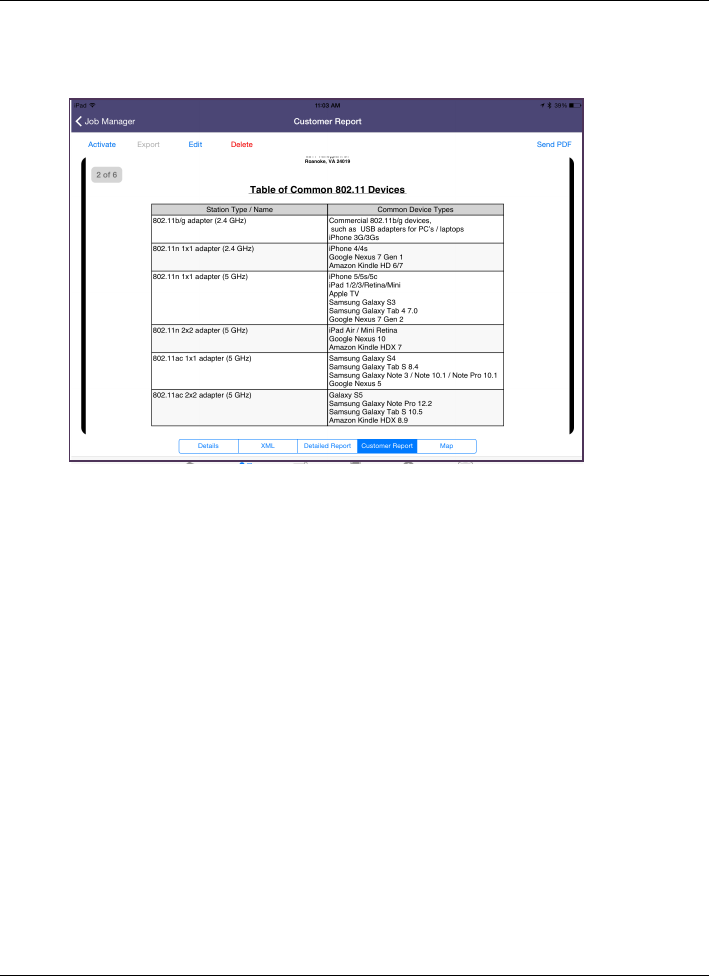
Chapter 3 Testing
Managing jobs
WiFi Advisor Wireless LAN Analyzer User’s Guide
December 2014 22073751, Rev. 002 Page 39
Exporting jobs
Jobs can be exported from the iPad to an external database using either FTP or
HTTPS (if available).
To export a job
1 From the main Job Manager screen, touch Manage.
Active jobs are listed.
2 Choose the desired job by selecting the box next to the job.
3 Touch Export.
4 Touch the information icon (small “i” within a circle) at the bottom left corner
of the Job Manager screen
Figure 15 Customer Report example

Chapter 3 Testing
Managing jobs
WiFi Advisor Wireless LAN Analyzer User’s Guide
Page 40 22073751, Rev. 002 December 2014
5 The Edit FTP Settings menu appears.
If your version of software has both FTP and HTTPS export capability,
touching the HTTPS button will exchange the Edit FTP Settings dialogue
with the Edit HTTPS Settings dialogue.
6 Enter the URL, user name and password, and other information required to
point the WiFi Advisor iOS application to your FTP or HTTPS site or data-
base.
7 If any jobs have been exported, Export History appears in the lower right.
Use the history to view previously exported jobs.
Deleting jobs
Jobs can be selectively deleted from the iPad.
To delete a job
1 From the main Job Manager screen, touch Manage.
Active jobs are listed.
2 Choose the desired job by selecting the box next to the job
3 Touch Delete.

Chapter 3 Testing
Troubleshooting Problems with Your WiFi Advisor
WiFi Advisor Wireless LAN Analyzer User’s Guide
December 2014 22073751, Rev. 002 Page 41
Troubleshooting Problems with Your WiFi Advisor
Please refer to the following table if your WiFi Advisor does not seem to be
performing correctly. If you still cannot solve your problem, please contact JDSU
Technical Assistance on 1-855-ASK-JDSU (1-855-275-5378) or by email at:
TAC@jdsu.com.
Problem Action
Cannot connect the mobile
app to the WFED-300AC – Check that Bluetooth is ON (enabled) on your iPad.
– Make sure that the iPad and WFED-3000AC are
within reasonable Bluetooth range of each other
(ideally 0 to 20 feet)
– Look at the number of Bluetooth devices in the
area. Three to four devices is a practical limit,
depending on the types of devices and profiles
used. Some devices require more Bluetooth data,
so they are more demanding than other devices.
Data-intensive devices may reduce the total num-
ber of devices that can be active at the same time.
If a Bluetooth device becomes slow to connect or
does not perform reliably, reduce the total number
of connected devices.
The WFED-300AC is
unresponsive (locked-up) – Press and hold the power button for 5 seconds.

Chapter 3 Testing
Troubleshooting Problems with Your WiFi Advisor
WiFi Advisor Wireless LAN Analyzer User’s Guide
Page 42 22073751, Rev. 002 December 2014

A
WiFi Advisor Wireless LAN Analyzer User’s Guide
December 2014 22073751, Rev. 002 Page 43
Append ix A
Maintenance and Specifications
This chapter describes how to maintain your unit. Topics discussed in this chapter
include the following:
•“Charging the battery” on page 44
•“Replacing the battery pack” on page 44
•“Cleaning the instrument” on page 45
•“Specifications” on page 46
•“Getting Technical Assistance” on page 47
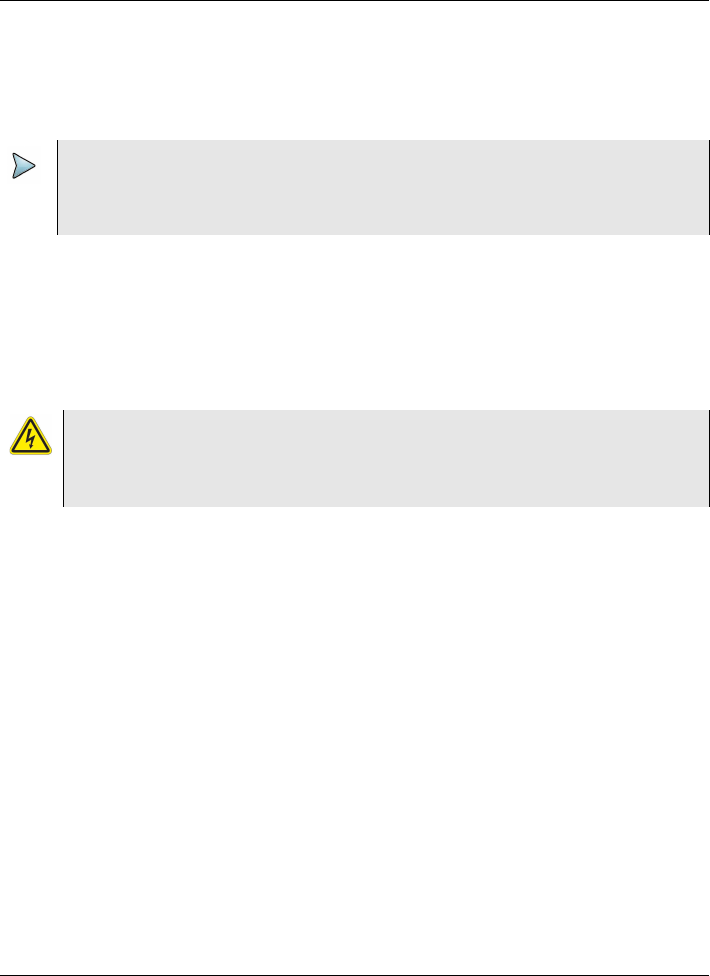
Appendix A Maintenance and Specifications
Charging the battery
WiFi Advisor Wireless LAN Analyzer User’s Guide
Page 44 22073751, Rev. 002 December 2014
Charging the battery
When the Batt LED lights red, the battery pack should be charged or replaced.
To charge the battery
1 Connect one end of the AC adapter to the connector on the back of the WiFi
Advisor.
2 Connect the other end of the AC adapter to an AC power supply.
3 Let the WiFi Advisor charge for 5 hours for a fast charge; for maximum
capacity, allow the WiFi Advisor to (trickle) charge overnight.
The charging time will be the same whether the power is on or off.
The Batt LED is amber when the unit is fast charging. The WiFi Advisor will
trickle charge at other times when the charger is connected and the Batt LED
is green.
After the Batt LED turns green (fast charge is complete), allow the unit to
trickle charge overnight for maximum performance.
Charging the battery pack is complete.
Replacing the battery pack
The battery compartment is located on the bottom of the unit.
The following procedure describes how to replace the battery pack.
NOTE:
You can test a circuit and recharge the battery at the same time. If you do not want to
interrupt the current test, you may leave the power on and connect the AC power
adaptor.
WARNING: ELECTRICAL SHOCK
Electrical shock may result in serious injury or death. Be sure the AC Adapter is con-
nected to the correct voltage mains. Do not use outdoors or in wet locations. Use
only the AC Adapter supplied with the test set.
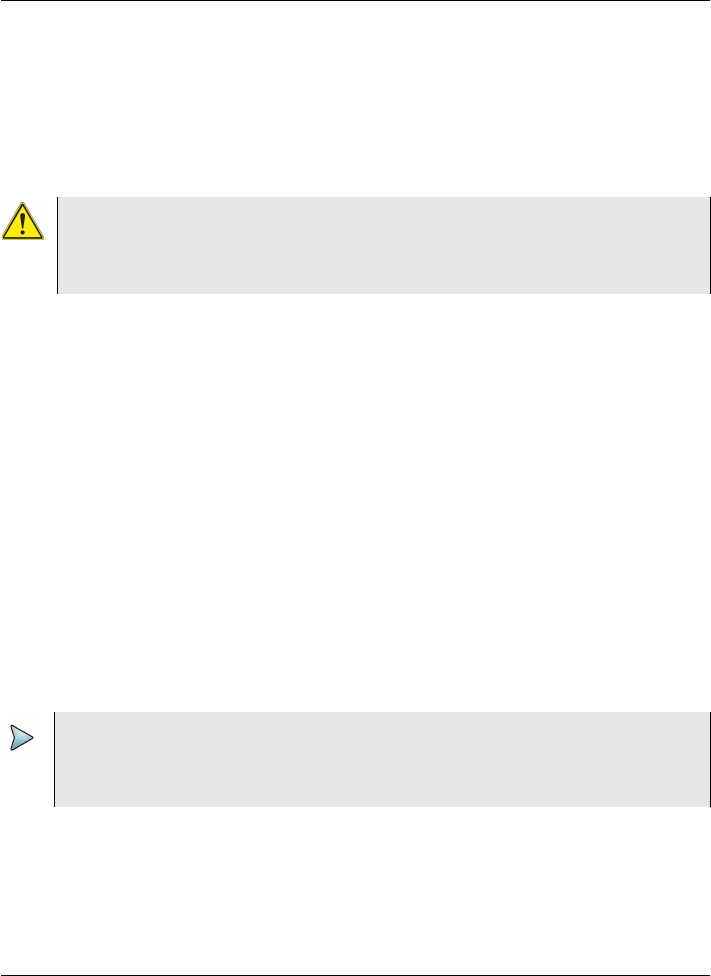
Appendix A Maintenance and Specifications
Cleaning the instrument
WiFi Advisor Wireless LAN Analyzer User’s Guide
December 2014 22073751, Rev. 002 Page 45
Before replacing the battery pack, verify that the replacement battery pack is JDSU
part number 21108524.
To replace the battery pack
1 Turn the power off.
2 Pull the two tabs to release the door.
3 Unplug the battery pack wiring.
4 Remove the old battery pack.
5 Insert the new battery pack, with the label facing up and aligning the wiring
toward the connector.
6 Connect the new battery pack to the wiring.
7 Replace the battery compartment door.
Replacing the battery pack is complete.
Cleaning the instrument
The instrument itself does not require any specialized cleaning. An occasional wipe
with a damp cloth is sufficient.
CAUTION: INSTRUMENT DAMAGE
Failure to turn the power off before removing the battery pack from the WiFi Advisor
could damage internal components and/or corrupt the software. Always power down
the unit before removing the battery pack.
NOTE:
When cleaning the instrument, JDSU recommends a damp cloth and water only.
Cleaning with chemicals could cause damage to the plastic case, buttons, or removal
of markings.

Appendix A Maintenance and Specifications
Specifications
WiFi Advisor Wireless LAN Analyzer User’s Guide
Page 46 22073751, Rev. 002 December 2014
Specifications
This section provides specifications for the WiFi Advisor.
Table 5 Physical specifications
Parameter Specification
Height 6.1” / 155 mm
Width 7” / 178 mm
Depth 2.6” / 66 mm
Weight 1 lb. / 0.45 kg, with battery
Table 6 Operating and storage environment
Parameter Specification
Operating Temperature 32° to 104° F (0° to +40° C)
Storage Temperature -22° to 140° C (-30° to 60° C)
Humidity 10%-90% RH non-condensing
Vibration 3-Axis Vibration
Shock ±3 half-sinusoidal shock, 3-Axis Shock

Appendix A Maintenance and Specifications
Getting Technical Assistance
WiFi Advisor Wireless LAN Analyzer User’s Guide
December 2014 22073751, Rev. 002 Page 47
Getting Technical Assistance
If you need assistance or have questions related to the use of this product, use the
information in Table 7 to contact JDSU’s Technical Assistance Center (TAC) for
customer support. For the latest TAC contact information, go to www.jdsu.com or
contact your local sales office for assistance.
The regional sales office phone numbers are listed on the back of this manual.
During off-hours, you can request assistance by doing one of the following: leave a
voice message at the TAC for your region; email the North American TAC
(tac@jdsu.com); submit your question using our online Technical Assistance
request form at www.jdsu.com.
Table 7 Technical assistance centers
Region Phone Number
Americas 1-855-ASK-JDSU (option #3)
1 301 353 1560 (1-855-275-5378, option #3)
tac@jdsu.com
Europe, Africa, and
Mid-East +49 (0) 7121 86 1345
(JDSU Germany) hotline.europe@jdsu.com
Asia and the Pacific +852 2892 0990
(Hong Kong)
+86 10 6655 5988
(Beijing-China)

Appendix A Maintenance and Specifications
Getting Technical Assistance
WiFi Advisor Wireless LAN Analyzer User’s Guide
Page 48 22073751, Rev. 002 December 2014

B
WiFi Advisor Wireless LAN Analyzer User’s Guide
December 2014 22073751, Rev. 002 Page 49
Append ix B
WiFi Fundamentals
This chapter provides a general description WiFi and 802.11. Topics discussed in
this chapter include the following:
•“WiFi deployment” on page 50
•“Network standard” on page 50
•“802.11 specifications” on page 51
•“Spectrum Differences” on page 51

Appendix B WiFi Fundamentals
WiFi deployment
WiFi Advisor Wireless LAN Analyzer User’s Guide
Page 50 22073751, Rev. 002 December 2014
WiFi deployment
Successful WiFi service delivery is highly dependent on a vulnerable RF physical
medium that is dynamically shared, along with complex L2 (i.e. 802.11) and
supporting protocols. This makes installation of service a potentially complex task.
Reliance on simplistic installation methods that do not provide an indication of
robust service level margin can impact QoE (quality of experience) as the RF envi-
ronment / network changes, resulting in trouble calls, repeats and churn.
Inability to assess 802.11 performance and true throughput at critical locations
throughout the home leaves the end user guessing as to how the installed network
should perform, leading to trouble calls and truck rolls as the end user adds to /
modifies the WiFi network.
Network standard
The network standard uses RF (radio frequency) spectrum as the physical layer.
That means no wires, but can have issues with walls, mirrors and certain other
building materials. The network standard has protocols to handle some interferers,
such as:
•Co-channel (same channel) interferers can cooperate transmission (take
turns).
•Burst interference mitigation by delayed transmission
•Adjacent Channel interferers are an issue
•Non-802.11 interferers are a big problem because they can appear as 802.11
but do not adhere to protocols. Your 802.11 radio will wait to get the “ok” to
transmit, which may never come. It also can de-sensitize the receiver since
the packets may not be received, the transmitter will keep sending the
message “waiting for an acknowledgement”
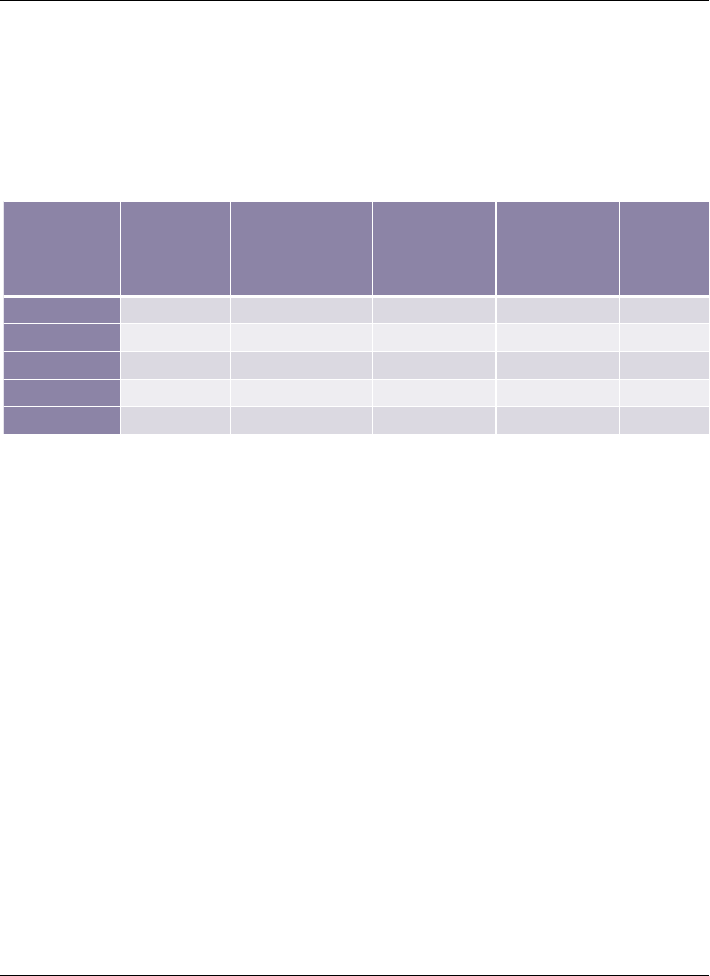
Appendix B WiFi Fundamentals
802.11 specifications
WiFi Advisor Wireless LAN Analyzer User’s Guide
December 2014 22073751, Rev. 002 Page 51
802.11 specifications
802.11 is the “parent” of a family of Institute of Electronics and Electronic Engi-
neering (IEEE) specifications for wireless LAN.
The standard has undergone several revisions:
Spectrum Differences
Understanding the different spectrums and channel allocations can help identify
trouble areas.
2.4 GHz Spectrum
In North America, there are 11 channels, each 22 MHz wide. These channels
overlap, except for 1, 6 and 11. Thus, these channels are always preferred.
The rest of the world includes two additional channels (12 and 13).
Figure 16 provides a map of the channel allocation for the 2.4 Ghz spectrum. Indus-
trial, Science and Mechanical (ISM)” is the band that can be used by anything that
Protocol
Main
Frequency
Band
(GHz)
Max Data Rate
(Mbps)
BW
(MHz) Modulation MIMO
Support?
802.11a 5 54 20 OFDM No
802.11b 2.4 11 22 DSSS No
802.11g 2.4 54 20 OFDM/DSSS No
802.11n 2.4/5 65/135 20/40 OFDM 4
802.11ac 5 86/180/390/780 20/40/80/160 OFDM 8
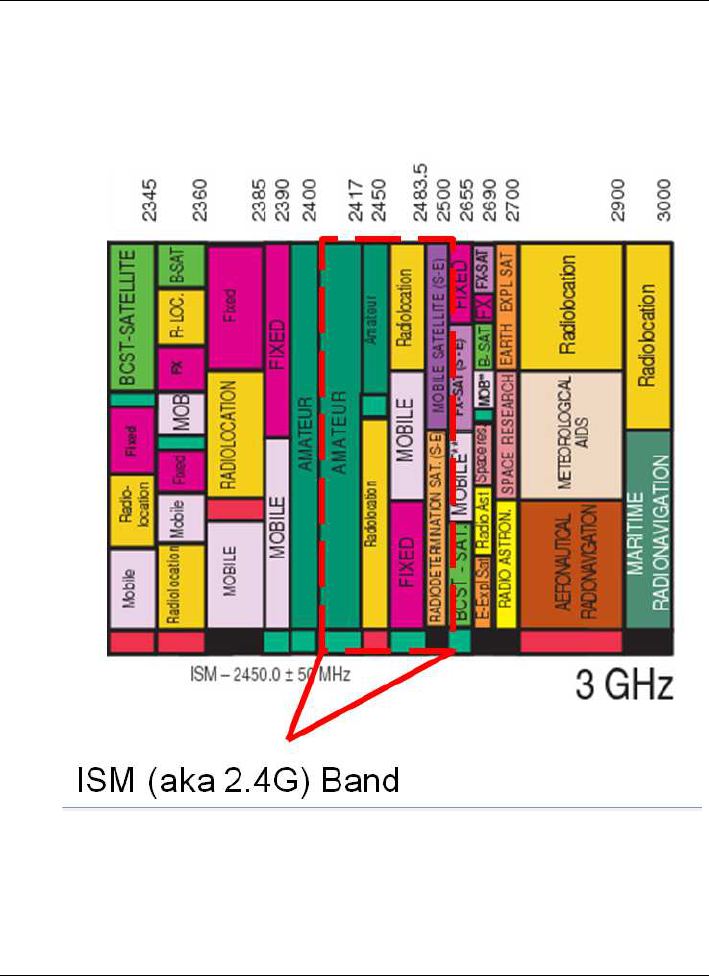
Appendix B WiFi Fundamentals
Spectrum Differences
WiFi Advisor Wireless LAN Analyzer User’s Guide
Page 52 22073751, Rev. 002 December 2014
gets a FCC Part 15 approval (Bluetooth devices, cordless telephones, baby moni-
tors and microwave ovens).
Figure 16 2.4G channel allocation
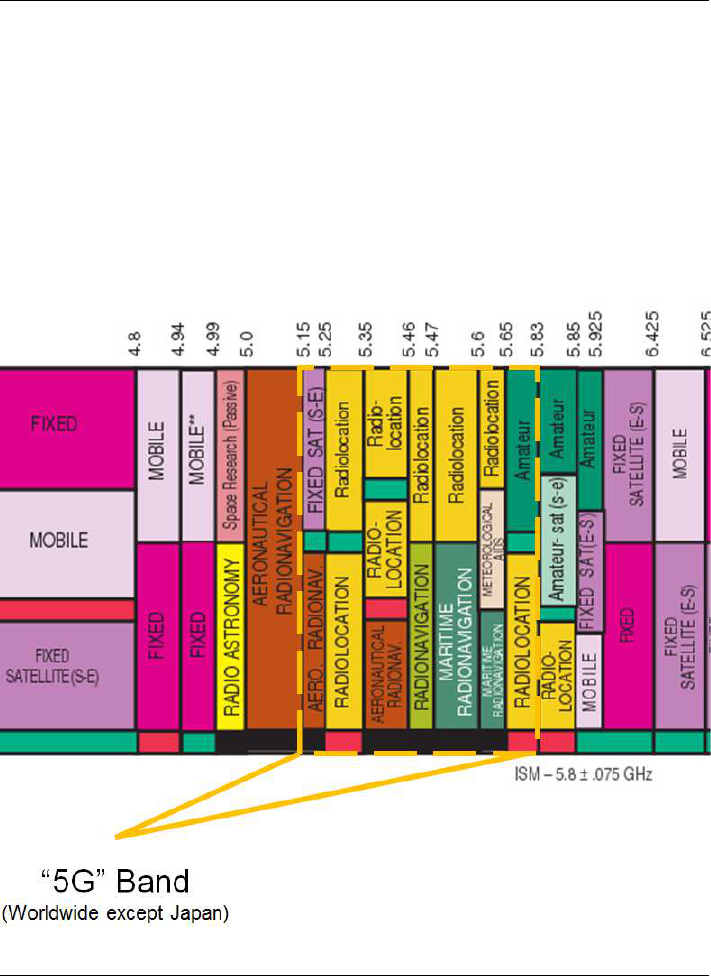
Appendix B WiFi Fundamentals
Spectrum Differences
WiFi Advisor Wireless LAN Analyzer User’s Guide
December 2014 22073751, Rev. 002 Page 53
5 GHz Spectrum
A lot of these frequencies are used for satellite communications (low power). That
means to them, WiFi is the interferer. U-NII stands for Unlicensed National Informa-
tion Infrastructure and was set aside primarily for WiFi use. Most of the world uses
the spectrum from 5.18 – 5.835 GHz. Note that another ISM band exists here (cord-
less telephones, point-to-point radios, baby monitors).
Figure 17 provides a map of the channel allocation for the 5 Ghz spectrum.
Figure 17 5G channel allocation
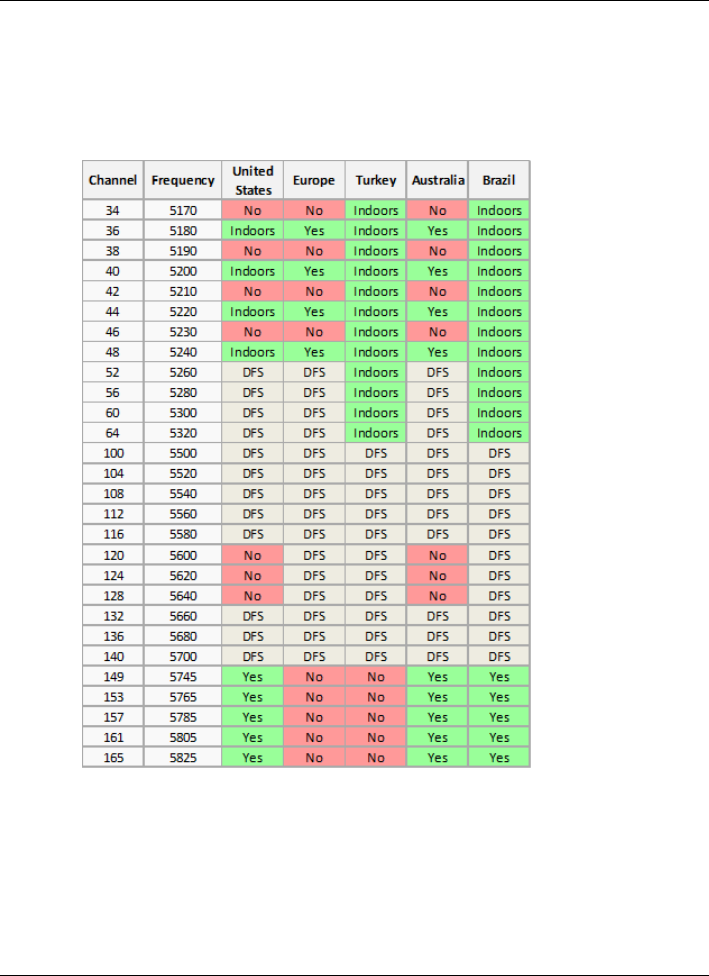
Appendix B WiFi Fundamentals
Spectrum Differences
WiFi Advisor Wireless LAN Analyzer User’s Guide
Page 54 22073751, Rev. 002 December 2014
This band can vary in a greater number of regions, as shown in Figure 18,
and.certain channels are designated as indoor use only or outdoor use.
The terms “Indoor” or “Outdoor” relate to output power restrictions on the radios.
Figure 18 International channel map

C
WiFi Advisor Wireless LAN Analyzer User’s Guide
December 2014 22073751, Rev. 002 Page 55
Append ix C
Customer Services and Support
This appendix provides information about standard support services, add-on
services, and training available through JDSU. Topics discussed in this appendix
include:
•“About our services” on page 56
•“Standard support services” on page 56
•“Add-on services” on page 57
•“Training options” on page 59

Appendix C Customer Services and Support
About our services
WiFi Advisor Wireless LAN Analyzer User’s Guide
Page 56 22073751, Rev. 002 December 2014
About our services
JDSU offers an unmatched and comprehensive portfolio of standard support
services, add-on services, and training options to help customers successfully use
purchased JDSU products. Services that come standard with every product sale
include business hour technical assistance, in-warranty repair, calibration services,
upgrade services, and immediate return authorizations. Add-on services designed
to optimize product capabilities and maximize efficiencies include field engineering
and deployment, technical training, 24x7 product support, consulting, and custom
software development. Refer to the sections that follow for additional details.
Standard support services
Standard support services that accompany the sale of every JDSU product include:
•Instrument repair and calibration services
•Business hour technical assistance
•Access to general warranty information on the JDSU Web site
•Extensive product documentation and related technical information, acces-
sible on the JDSU Web site
For more information, refer to the following subsections.
Instrument repair and calibration services
Our service centers provide repair and calibration services for JDSU equipment.
JDSU understands the impact of equipment down time on operations and is staffed
to ensure a quick turnaround. Available services include the following:
Product Repair — All equipment returned for service is tested to the same rigorous
standards as newly manufactured equipment. This ensures products meet all
published specifications, including any applicable product updates.
Calibration — JDSU’s calibration methods are ISO approved and based on
national standards.

Appendix C Customer Services and Support
Add-on services
WiFi Advisor Wireless LAN Analyzer User’s Guide
December 2014 22073751, Rev. 002 Page 57
For more information, including instructions for returning equipment for repair and/
or calibration, go to: www.jdsu.com/en-us/Test-and-Measurement/support/repair-
and-calibration/Pages/default.aspx.
Technical assistance (business hour)
Expert business hour technical support is provided with your product. For assis-
tance related to the use of your product, call or e-mail JDSU’s Technical Assistance
Center (TAC) in your region. For a current listing of TAC phone numbers and e-mail
addresses, go to: www.jdsu.com/en-us/Test-and-Measurement/support/technical-
assistance/Pages/default.aspx.
For information about optional 24x7 technical assistance, see “Extended product
and systems support services” on page 58.
Warranty information
Information about standard warranties, terms, and conditions specific to JDSU’s
Test & Measurement products and third party software that may be included within
such products is posted on the JDSU Web site. For more information, go to:
www.jdsu.com/terms.
Product documentation library
An extensive library that includes documentation for JDSU products and related
technology-specific documents is available on the JDSU Web site. For more infor-
mation, go to: www.jdsu.com/en-us/Test-and-Measurement/support/Technical-
Library/Pages/TechLibrary.aspx.
Add-on services
JDSU offers a broad portfolio of add-on services to enable customers to aggres-
sively build their competitive advantage within the markets they serve. Available
services include:

Appendix C Customer Services and Support
Add-on services
WiFi Advisor Wireless LAN Analyzer User’s Guide
Page 58 22073751, Rev. 002 December 2014
•Extended product and systems support, including:
– Optional extended product warranties
– Optional extended repair services
– Calibration management services
– Around-the-clock technical assistance
– A certified pre-owned equipment program
– Tailored support services for your JDSU system
•Various professional and consulting services
•Specialized managed services
For more information, refer to the following subsections.
Extended product and systems support services
For information about optional extended product warranties, go to: www.jdsu.com/
en-us/Test-and-Measurement/services/a-z-service-list/Pages/ext-warr.aspx.
For information about optional extended equipment repair services, go to:
www.jdsu.com/en-us/Test-and-Measurement/services/a-z-service-list/Pages/
factory-repair.aspx.
For information about equipment calibration management services, go to:
www.jdsu.com/en-us/Test-and-Measurement/services/a-z-service-list/Pages/cali-
bration.aspx.
For information about optional 24x7 technical assistance, go to: www.jdsu.com/en-
us/Test-and-Measurement/services/a-z-service-list/Pages/tac.aspx.
For information about JDSU’s Assets and Certified Equipment (ACE) Program (for
the resale of certified pre-owned equipment), go to: www.jdsu.com/en-us/Test-and-
Measurement/services/a-z-service-list/Pages/ace-prgm.aspx.
For information about tailored support services for your JDSU system, go to:
www.jdsu.com/en-us/Test-and-Measurement/services/products-and-systems-
support/systems-support/Pages/default.aspx.

Appendix C Customer Services and Support
Training options
WiFi Advisor Wireless LAN Analyzer User’s Guide
December 2014 22073751, Rev. 002 Page 59
Professional and consulting services
For information about optional professional and consulting services available from
JDSU, go to: www.jdsu.com/en-us/Test-and-Measurement/services/professional-
and-consulting-services/Pages/default.aspx.
Managed services
For information about specialized managed services available from JDSU, go to:
www.jdsu.com/en-us/Test-and-Measurement/services/managed-services/Pages/
default.aspx.
Training options
JDSU offers a wide array of training options designed to support customers at
various stages of the network life cycle. Training options include:
•Public training
•On-site training
•Virtual classroom
•Self-paced training
•Certifications
•Workshops and blended learning
•Train-the-trainer/course licensing
•Free Webinars
•Contact training
For more information about available training options, go to: www.jdsu.com/en-us/
Test-and-Measurement/Training/Pages/default.aspx.

Appendix C Customer Services and Support
Training options
WiFi Advisor Wireless LAN Analyzer User’s Guide
Page 60 22073751, Rev. 002 December 2014

WiFi Advisor Wireless LAN Analyzer User’s Guide
December 2014 22073751, Rev. 002 Page 61
Glossary
A
AP — Access Point. The 802.11 device which allows wireless devices to connect
to a wired network (in general)
B
BSSID — Basic service set identifier. An identifier that represents a single 802.11
cell (similar to a MAC address)
C
Client — Client – device with connects to an access point, does not function as an
AP (but can operate as a wired to wireless “adapter”)
CPE — Customer Premise Equipment
D
DSSS — Digital Sequence Spread Spectrum. A type of Modulation.
M
MIMO — Multiple Input, Multiple Output antenna – simultaneous (and smart; each
antenna can choose RF signals) transmit and receive (referenced as “mxn
antennas” such as 2x2 or 3x3)
Modulation — RF (analog) delivery mechanism of digital data (FM is a type of
modulation)

Glossary
WiFi Advisor Wireless LAN Analyzer User’s Guide
Page 62 22073751, Rev. 002 December 2014
MTTO — Mean Time To Optimize
MTTR — Mean Time To Repair
O
OFDM — Orthogonal Frequency Division Multiplexing
R
Retransmission retries — For packets requiring retransmission, this is the
number of retries required to successfully retransmit the packet
RF — Radio Frequency. RF energy can cause interference
RSSI — Received Signal Strength Indication
S
SNR — Signal to Noise Ratio
Spectral — A spectrum analyzer is used to measure signal amplitude (strength) as
it varies by signal frequency. The frequency appears on the horizontal axis, and the
amplitude is displayed on the vertical axis.
A spectrum analyzer can be used to determine whether or not a wireless transmitter
is working according to federally defined standards for purity of emissions. Output
signals at frequencies other than the intended communications frequency appear
as vertical lines (blips) on the display. A spectrum analyzer can also be used to
determine, by direct observation, the bandwidth of a digital or analog signal.
SSID — Service Set Identifier. The network that we are connected to (or attempting
to connect to).

WiFi Advisor Wireless LAN Analyzer User’s Guide
December 2014 22073751, Rev. 002 Page 63
Index
Numerics
2.4G spectrum 51
5G spectrum 53
802.11 specifications 51
A
App, iPad 8
B
Battery
recharging 44
replacement 44–45
replacing 44
Battery pack 44
Buttons 4
C
Calibration 56
Cleaning the instrument 45
Compliance information xii
Configuration, site assessment 28
Connectors 4
F
Features 3
Firmware, updating 14
H
Host software update 15
I
Indicators 4
Interpreting messages 47
M
Maintenance
battery replacement 44
charging the battery 44
cleaning the instrument 45
updating firmware 14
Messages, interpreting 47
O
Overview 3

Index
WiFi Advisor Wireless LAN Analyzer User’s Guide
Page 64 22073751, Rev. 002 December 2014
P
Pairing devices with the iPad 12
Product repair 56
Q
Quick tour 4
R
Recharging the battery 44
Registering devices on the iPad 12
Replacing the batteries 44–45
Replacing the battery 44
S
Safety information xii
Single-ended test 18
Site assessment
configuring 28
description 25
test 30
Specifications 46
Spectral measurements 24
Spectrum analyzer 23
T
Testing
single-ended 18
site assessment 30
two-ended 25
U
Updating
host software 15
unit firmware 14
W
WiFi Advisor iPad app 8
WiFi fundamentals 49

